An Oral History of Glastonbury Festival 1992 | reviews, news & interviews
An Oral History of Glastonbury Festival 1992
An Oral History of Glastonbury Festival 1992
Take a 29 year time-trip back to the world's greatest festival with those who were there
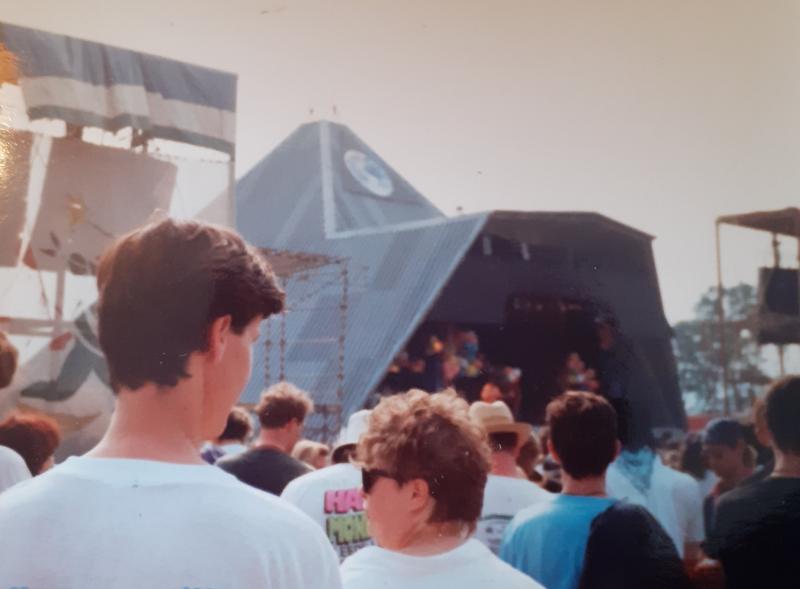
There is never one Glastonbury Festival. There are as many Glastonbury Festivals as there are people who attend. Thus it ever was, even back in 1992 when the capacity was only 70,000 (plus multitudinous fence-jumpers!).
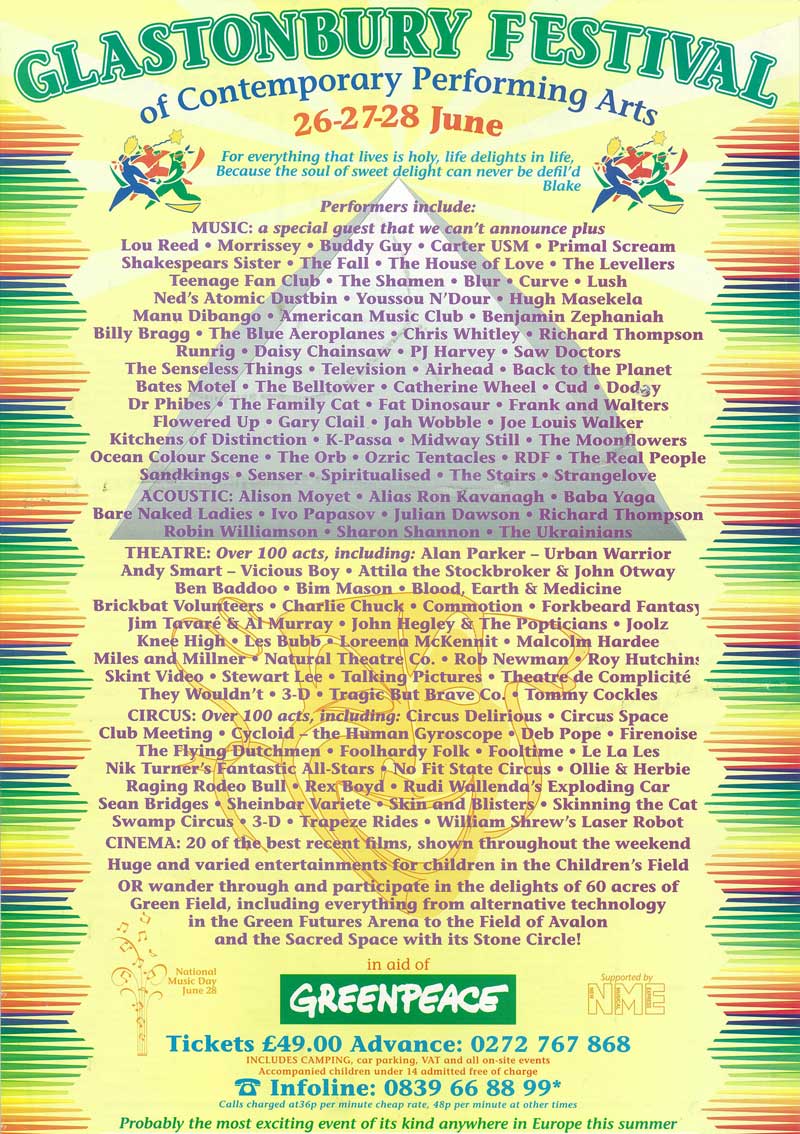 The interviewees appear with their age in late June '92 and their relationship to the ’92 festival. Memories are presented chronologically, by day, with events in loose order, but this is as much an eventful ramble around those long ago fields. At 12,500 words long it should be approached as the reader wishes. Those who want to lose themselves in it can enjoy the whole trip, including adventures before and after. On the other hand, those who simply want to scroll down to the bands are free to do so. You can also follow individual narratives - those expecting babies, those running illegal sound systems, even those whose relationships were crumbling catastrophically in a lysergic haze - or you can just dip in for a micro-dose.
The interviewees appear with their age in late June '92 and their relationship to the ’92 festival. Memories are presented chronologically, by day, with events in loose order, but this is as much an eventful ramble around those long ago fields. At 12,500 words long it should be approached as the reader wishes. Those who want to lose themselves in it can enjoy the whole trip, including adventures before and after. On the other hand, those who simply want to scroll down to the bands are free to do so. You can also follow individual narratives - those expecting babies, those running illegal sound systems, even those whose relationships were crumbling catastrophically in a lysergic haze - or you can just dip in for a micro-dose.
Of course, there’s loads missing - notably, I couldn’t obtain an interview with Sunday Pyramid headliner Youssou N’Dour, or get hold of anyone who'd seen his set – but I reckon a solid flavour of what it was like is here. As befits Glastonbury’s deranged, hedonic mythos, some matters remain opaque, despite months of research. When did The Levellers play? Certainly not when the festival programme suggests, but different memories suggest different timelines. Or what about Glasto-legendary rave hub, the Joe Bananas blanket stall – was it there in 1992 or did it appear later in the decade?
“Why 1992,” you may reasonably ask? The answer is that last year, due to the COVID-induced lack of a festival, theartsdesk presented regular Glastonbury reviewer Caspar Gomez’s 30th anniversary report on the 1990 festival. There was no festival in 1991 so right now the nearest option is 1992. It was a good year, after all. Like Glastonbury itself, what follows is excessive and sprawling. It’s written for everyone, but is especially for those gagging, right now, to be back in those Worthy Farm fields.
A huge thank you to all who took part and who allowed their words and/or their photographs to be used.
But now, let us move backwards through those decades...
THURSDAY 25th JUNE and before
Liz Eliot, 51, Green Fields co-ordinator: I lived in a bender that year, which was a bent hazel pole construction with a tarp chucked over it. I arrived in the first week of June, after having the year off in Spain, to find [Green Fields arrangements] somewhat chaotic. I'm not a neat, tidy person but I felt each area would benefit from its own person who’d look after it, and a crew to keep it tidy; the Alternative Technology field, the Green Futures and Craft Field, the Healing field and the Green Kids area. That was the first year structured like that and it worked. It's the same format we have now.
John Sauven, 37, Greenpeace Director of Communications: After the 1990 festival, Michael Eavis phoned me up and asked if Greenpeace wanted to be involved. I’d moved to work there from CND [who Glastonbury had partnered with during the Eighties]. There was one director who was concerned about the image of the festival, but Lord Melchett was head of Greenpeace then and he’d championed festivals in the House of Lords, he’d worked in the Release tent at Glastonbury, and he was very supportive. So in the end it was quite a smooth transition. At the beginning Greenpeace did all the information points at the gates, and we promoted the festival to all our supporters. We provided a service and in return we got a donation. We developed the whole idea of having a Greenpeace Field and in 1992 turned the original structure of the Jazz Stage into the Rainbow Warrior, rebuilt it in the shape of a ship.
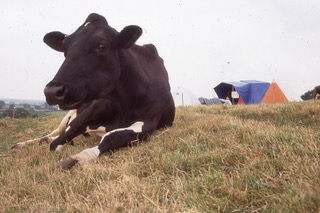
Ivan McBeth, 39, designer of Worthy Farm Stone Circle: I had been passionately interested and inspired by megalithic culture and structures for as long as I can remember. My belief is that the main purposes of stone circles are to provide a network to regulate energy flows between heavenly bodies and the earth, to be guardians of the secrets through which humanity can realise its divinity. In February 1992 I got the go-ahead to design and build a permanent Stone Circle at Worthy Farm.
Liz Eliot, 51, Green Fields co-ordinator: Ivan McBeth planned the Stone Circle really carefully, based on and aligned with the constellation Cygnus the Swan, the main star sign above in mid-summer. He bought over a driver called Keith with a JCB who was meticulous in following Ivan's instructions on digging the holes. Then they did ceremonies; they put tiny crystals underneath the stones to charge them into spiritual activity. Then the stones were lowered, inch by inch, into the right places by the JCB. It's recharged every year by the revellers who come.
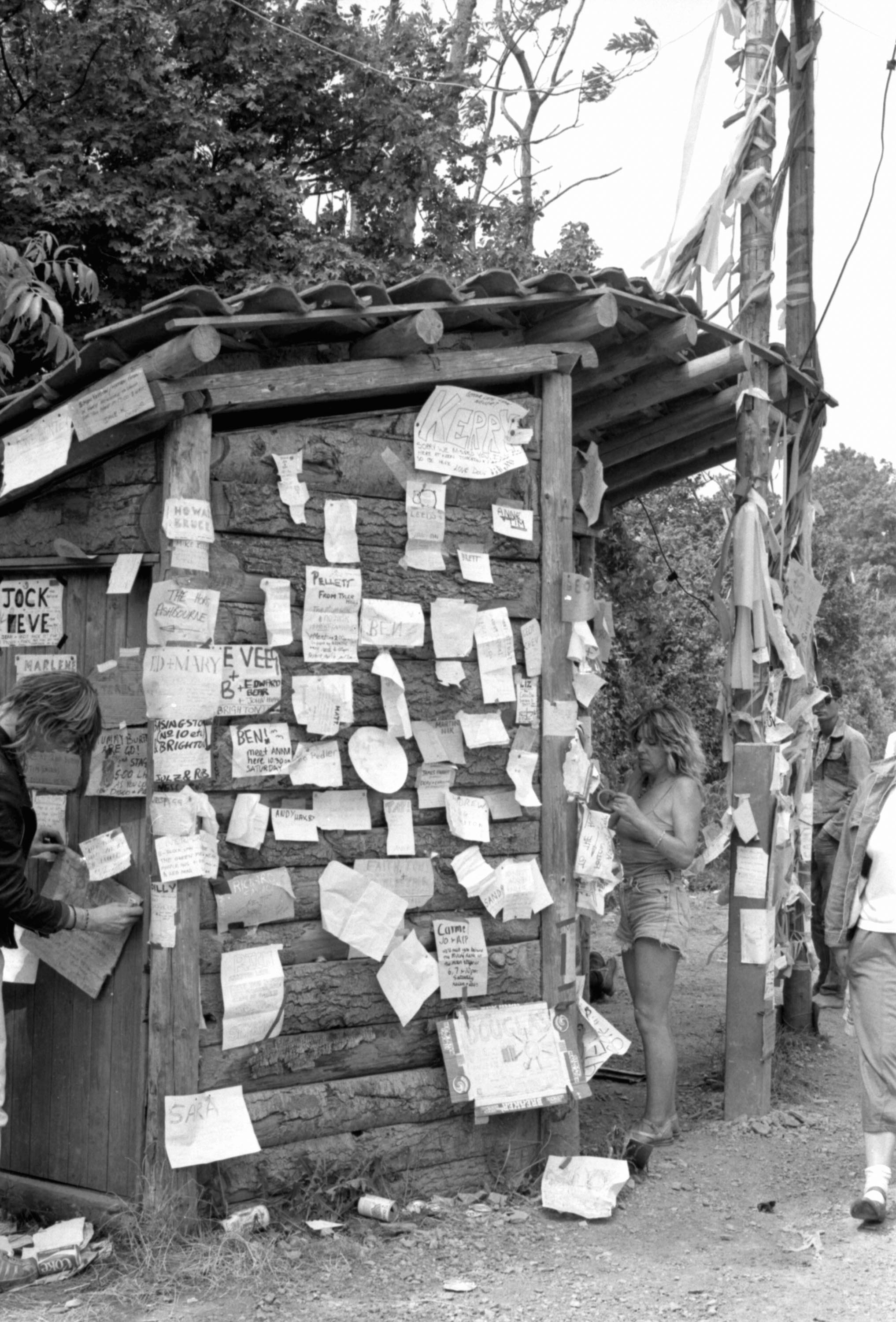 Kevin Geraghty-Shewan, 30, festival-goer: Our daughter Bethany was nearly 18 months old and my partner Val was seven months pregnant, so we had a few concerns about going to the festival. We wondered what would happen if Val went into labour. I searched all the info we’d been sent but couldn't find any number to call that wasn’t a recorded message. In desperation I called a number that was in the info leaflet for traders, hoping they’d be able to point me in the right direction. The phone rang a few times before it was answered. “Worthy Farm”. I apologised and explained the situation, the girl who answered said she would put Mrs Eavis on. Once again, I explained our dilemma and she listened before saying that in her opinion Val would be better off having her baby at the festival than in many of the local hospitals.
Kevin Geraghty-Shewan, 30, festival-goer: Our daughter Bethany was nearly 18 months old and my partner Val was seven months pregnant, so we had a few concerns about going to the festival. We wondered what would happen if Val went into labour. I searched all the info we’d been sent but couldn't find any number to call that wasn’t a recorded message. In desperation I called a number that was in the info leaflet for traders, hoping they’d be able to point me in the right direction. The phone rang a few times before it was answered. “Worthy Farm”. I apologised and explained the situation, the girl who answered said she would put Mrs Eavis on. Once again, I explained our dilemma and she listened before saying that in her opinion Val would be better off having her baby at the festival than in many of the local hospitals.
Jiří Sandoz, 21, festival-goer: It was the end of my first year at the University of Birmingham doing Film & Drama. Most of my friends were finished but I had to do a play on the evening of Monday 29th. I was the last character to say the last line, so I had to stay at college while all my mates – and my girlfriend - went off to Glastonbury. My relationship was going a bit wrong, so I skipped home to London because I was pissed off. There was the usual stuff on the news – “Thousands of hippies are making their way to Glastonbury for the music festival.” I was moaning and my mum said, “If you're that pissed off, just go.” “But I haven’t got a ticket.” “That didn't stop me in going to the Bath Music Festival in 1970 - go or stop moaning!” My mum worked for British Rail so I took her travel card and some of the fridge full of strawberry LSD tabs we’d been using all term.
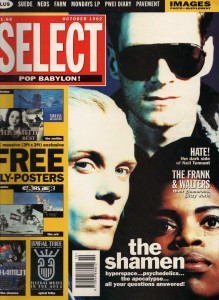 Andrew Harrison, 25, Select Magazine editor: I’d been to Glastonbury in the Eighties but it was a rainy disaster where the only band I saw – from the car park – was King. I always wanted to go back and in 1992 my calling card was Select Magazine. I hired a Winnebago, put the entire staff in it, drove them down, then parked directly behind the Pyramid Stage. We’d made a plan; we all knew the NME had the deal with Glastonbury but their coverage was just reviewing the bands and taking little black'n’white pictures up a guitarist’s nose. We were hoping to go into the experience, photograph the freaks, the ravers on stilts, the naked people. It’s a bit of a cliché now but it hadn’t been done before.
Andrew Harrison, 25, Select Magazine editor: I’d been to Glastonbury in the Eighties but it was a rainy disaster where the only band I saw – from the car park – was King. I always wanted to go back and in 1992 my calling card was Select Magazine. I hired a Winnebago, put the entire staff in it, drove them down, then parked directly behind the Pyramid Stage. We’d made a plan; we all knew the NME had the deal with Glastonbury but their coverage was just reviewing the bands and taking little black'n’white pictures up a guitarist’s nose. We were hoping to go into the experience, photograph the freaks, the ravers on stilts, the naked people. It’s a bit of a cliché now but it hadn’t been done before.
Stefan Linne, 31, Sheinbar Varieté (Circus Big Top, all three days): Sheinbar is the smallest variety theatre in Berlin with just 52 seats. At the beginning of Eighties we were the first to mix comedy, juggling, circus and variety stuff. Glastonbury asked us to come just two weeks before the festival. They’d wanted a group called Gosh 91 but they were already booked.
Graham Sugarlump, 32, Sugarlump Sound System: The guy who ran the market, Marcus, was a good friend of a friend of ours, and gave us a couple of acres just behind the Pyramid, along with a generator. We had no money, so what we did was separate an acre of the land and farmed it to friends who had businesses and could give us ren: More Balls Than Most, an up'n'coming juggling company, a vegetarian café from Stroud, and eight or nine others. With that money we went to a staging company in Ashford and bought a second-hand marquee which, we were told, belonged to Pink Floyd in the late Sixties. They delivered it to this field in Glastonbury on the Tuesday before the festival. This truck dropped it off and it was enormous, really heavy canvas, but it turned out to be just a stage covering, a roof; it didn't have sides. We were, like, “What? Where's the poles?” It was so heavy we couldn't even move it, so [Sugarlump associate] Steve Friend got the guys who made the hanging gardens you saw around the festival to give us a hand. They loved a challenge. They came down with a cherry picker and a whole bunch of telegraph poles and they built a frame, lashed it all together with rope, this 40 foot square marquee cover with a scalloped edge.
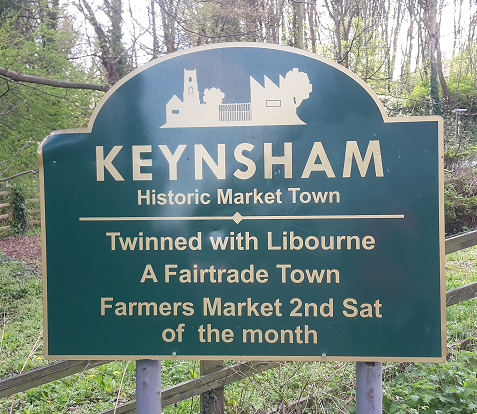 Angela B, 18, festival-goer: A group of us travelled down to the festival in a van and a hired minibus. The van broke down in a small village called Keynsham. This amused me because I liked this song Victoria Wood sang about Keynsham. The driver of the minibus promised to come back to collect us. Surprise, surprise, though, he didn’t, so we ended up spending the night in a small car park at the end of a road in Keynsham. It was next to this guy’s house and he came down with a tray of tea and biscuits because he felt sorry for us. Most of us thought it was nice of him, but it transpired he was also the community copper, keeping a bit of an eye on us. Not everyone was particularly happy about this because certain members of the group had taken a load of acid.
Angela B, 18, festival-goer: A group of us travelled down to the festival in a van and a hired minibus. The van broke down in a small village called Keynsham. This amused me because I liked this song Victoria Wood sang about Keynsham. The driver of the minibus promised to come back to collect us. Surprise, surprise, though, he didn’t, so we ended up spending the night in a small car park at the end of a road in Keynsham. It was next to this guy’s house and he came down with a tray of tea and biscuits because he felt sorry for us. Most of us thought it was nice of him, but it transpired he was also the community copper, keeping a bit of an eye on us. Not everyone was particularly happy about this because certain members of the group had taken a load of acid.
Bobby Gillespie, 30, Primal Scream (NME Stage, Friday): We played Exeter on Thursday night… then Glastonbury. It was the first festival we'd ever done. I’d never been to a festival in my life. I grew up going to punk and post-punk bands playing theatres and clubs. Festival culture was anathema to me. I just didn't know what Glastonbury was. I knew New Order and The Smiths played there back in the Eighties but when I looked at the line-up, it didn’t look very appealing, kind of WOMAD-ish. Our agent, Alex Nighintgale, bribed me to play, promised me something I don’t think he ever paid. But I’m glad he did
 Ben Graham, 21, litter-picker: Having just finished my final year at Middlesex University, on the Wednesday my girlfriend Marie and I took the Badgerline “Special Glastonbury Service” to Pilton, £7.50 return. We’d both signed up to join the Greenpeace litter-picking crew in return for a free ticket. The next day we got up 7.30 AM and had cold baked beans, tea and a couple of bread rolls. There was a general meeting where we were divided up into litter-picking teams. My team was led by a dopey, beardy bloke called Keith. He made us sit in a circle and throw oranges around and call out each other’s names and all that shit. We had to talk about ourselves and then ask after the person sat next to us, which in my case was Keith. It was all so false and crap.
Ben Graham, 21, litter-picker: Having just finished my final year at Middlesex University, on the Wednesday my girlfriend Marie and I took the Badgerline “Special Glastonbury Service” to Pilton, £7.50 return. We’d both signed up to join the Greenpeace litter-picking crew in return for a free ticket. The next day we got up 7.30 AM and had cold baked beans, tea and a couple of bread rolls. There was a general meeting where we were divided up into litter-picking teams. My team was led by a dopey, beardy bloke called Keith. He made us sit in a circle and throw oranges around and call out each other’s names and all that shit. We had to talk about ourselves and then ask after the person sat next to us, which in my case was Keith. It was all so false and crap.
Steve Bedlam, 20, Bedlam Sound System: I remember the festival not allowing us in because of the trouble between security and the travellers in 1990. So we ended up down in the carpark just outside Gate Three, which, funnily enough, is where we’re at now [Steve Bedlam oversees The Common area in the festival's notorious South-East Corner]. We were a family. We always ate together, always cooked together, we were a travelling show, essentially. Although it wasn’t a show most people in the normal festival world wanted to see. But the ravers were there, the ravers came out, and that really rejuvenated Glastonbury.
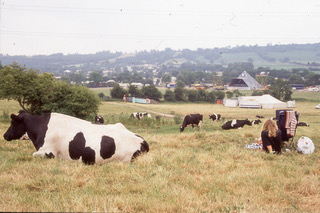 Rowan Chapman, 18, festival-goer: A bunch of us had just turned 18 and had finished A Levels and were due to go to universities across the country that September. It seemed a great idea for all of us to go to Glastonbury as a rite of passage into adulthood. A few of us had been before but most had never really left sheltered lives in the leafy, affluent commuter belt of Surrey. As we arrived on site and began setting up camp, I could see the mix of excitement, fear and trepidation in my friends’ eyes. Glastonbury is like no other place or festival. Your senses are overwhelmed and bombarded; sights, smells and sounds hitting you from every direction. The best advice I had was from an old hippy friend of my parents called “Rob the Herb” who said, “Just let it go, man, let go of everything you know and imagine you’re in Timbuktu - enjoy the ride!” So we took his advice, scored a load of hash and started to let go.
Rowan Chapman, 18, festival-goer: A bunch of us had just turned 18 and had finished A Levels and were due to go to universities across the country that September. It seemed a great idea for all of us to go to Glastonbury as a rite of passage into adulthood. A few of us had been before but most had never really left sheltered lives in the leafy, affluent commuter belt of Surrey. As we arrived on site and began setting up camp, I could see the mix of excitement, fear and trepidation in my friends’ eyes. Glastonbury is like no other place or festival. Your senses are overwhelmed and bombarded; sights, smells and sounds hitting you from every direction. The best advice I had was from an old hippy friend of my parents called “Rob the Herb” who said, “Just let it go, man, let go of everything you know and imagine you’re in Timbuktu - enjoy the ride!” So we took his advice, scored a load of hash and started to let go.
Eve Polycarpou, 37, Donna & Kebab (Outside Theatre and other stages, all three days): Trying to put the tent up was hysterical. Coming from these very typical, staid Greek-Cypriot households, we had no idea what to do. A couple of men were watching us thinking, “They're not going to get there,” so they took over.
 Kevin Geraghty-Shewan, 30, festival-goer: We had Val’s antenatal appointment the Wednesday the festival began so we packed everything into the car and set off for the hospital. Luckily Val was given a clean bill of health and off the three of us set to Glastonbury. We stopped on the way, at the red phone box you pass on as you drive through Castle Cary, to phone Val's mum to let her know, but she wasn’t in. Once parked up, we grabbed a big tent and air bed borrowed from my dad, and set off. Val found a purse someone had dropped. She took it back to the gate and handed it over to the security people. Almost immediately a girl came chasing after us, it was her purse, it was her first Glastonbury, the purse had all her money in, she couldn't thank us enough. It took several journeys to get all our stuff onto the site and then I had the embarrassment of blowing up the airbed. Back in those days the festival was attended by real hippies who shunned such luxuries but, as Val pointed out, they weren’t seven months pregnant.
Kevin Geraghty-Shewan, 30, festival-goer: We had Val’s antenatal appointment the Wednesday the festival began so we packed everything into the car and set off for the hospital. Luckily Val was given a clean bill of health and off the three of us set to Glastonbury. We stopped on the way, at the red phone box you pass on as you drive through Castle Cary, to phone Val's mum to let her know, but she wasn’t in. Once parked up, we grabbed a big tent and air bed borrowed from my dad, and set off. Val found a purse someone had dropped. She took it back to the gate and handed it over to the security people. Almost immediately a girl came chasing after us, it was her purse, it was her first Glastonbury, the purse had all her money in, she couldn't thank us enough. It took several journeys to get all our stuff onto the site and then I had the embarrassment of blowing up the airbed. Back in those days the festival was attended by real hippies who shunned such luxuries but, as Val pointed out, they weren’t seven months pregnant.
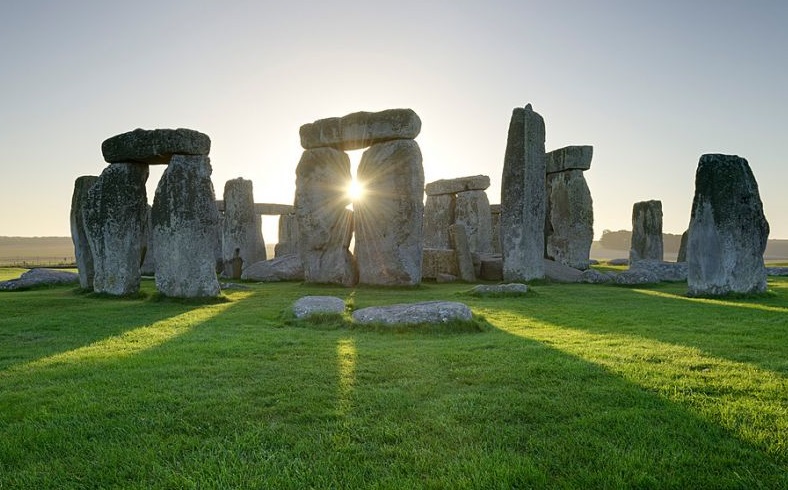 Tony Cordy, 35, Green Lights Oasis director: I was driving this huge yellow lorry from Suffolk with this massive circus trailer. Near Stonehenge we were pulled over by all these army guys slotted into police uniforms, in Transit vans with police stickers stuck on crooked. Our vehicle was supposed to have air brakes but one guy looks underneath and sees that not only does it not have air brakes but it’s all tied up with baler twine. So they called a little man out from the Ministry and he put a PG9 on it, which means you have to take it to a testing station, and it's legally not allowed to move. We had to phone up a rescue lorry, have the circus trailer winched onto the back of it, and arrived at Glastonbury like that. It cost us a lot of money. My name was on a list because I was involved with the Stone Henge festivals.
Tony Cordy, 35, Green Lights Oasis director: I was driving this huge yellow lorry from Suffolk with this massive circus trailer. Near Stonehenge we were pulled over by all these army guys slotted into police uniforms, in Transit vans with police stickers stuck on crooked. Our vehicle was supposed to have air brakes but one guy looks underneath and sees that not only does it not have air brakes but it’s all tied up with baler twine. So they called a little man out from the Ministry and he put a PG9 on it, which means you have to take it to a testing station, and it's legally not allowed to move. We had to phone up a rescue lorry, have the circus trailer winched onto the back of it, and arrived at Glastonbury like that. It cost us a lot of money. My name was on a list because I was involved with the Stone Henge festivals.
Pat Corley, 39, festival-goer and book-seller: As soon as we arrived in the car park, we were hassled by Hare Krishnas who wanted contributions for their free food tent. The gates were well organised, with proper turnstiles and friendly people to greet you on arrival. There was still a lot of wheeling’n’dealing going on outside, though, with dodgy geezers selling tickets or getting people in, under, over or through the fence. We camped just the other side of the hedge from where The Glade dance area is now [in 1992 it didn’t yet exist], a nice spot just off the main drag which was handy for my books.
 Angela B, 18, festival-goer: Walking along the road from Castle Cary, we could see the festival site open out before us. As we were taking that in, a horse-drawn cart came past and we struck up a conversation with the people in it. They turned out to be a circus troupe who were performing at the festival and offered to smuggle us in. They told us to hide ourselves under a mass of sheepskin rugs and blankets in the cart and to keep very, very quiet while they got through the gate. After what seemed like a long while, one of them shouted. “Right, that’s it, we’re in!” so we all emerged from under the blankets right in the middle of the festival. Naturally, we thanked them very much.
Angela B, 18, festival-goer: Walking along the road from Castle Cary, we could see the festival site open out before us. As we were taking that in, a horse-drawn cart came past and we struck up a conversation with the people in it. They turned out to be a circus troupe who were performing at the festival and offered to smuggle us in. They told us to hide ourselves under a mass of sheepskin rugs and blankets in the cart and to keep very, very quiet while they got through the gate. After what seemed like a long while, one of them shouted. “Right, that’s it, we’re in!” so we all emerged from under the blankets right in the middle of the festival. Naturally, we thanked them very much.
Kevin Geraghty-Shewan, 30, festival-goer: We’d arranged to meet some friends by either the milk stand which had, in previous years, been at the top of the hill, or by the cider bus. Unfortunately, both of them had been moved in a major reorganisation of the site (which has formed the basis of the festival’s layout ever since). We found them eventually. We spent the evening drinking by the cider bus until quite late. When we set off back to the tent I was really glad to have the pushchair to lean on to keep me upright, and the crowds just parted to let us through - or at least that's how it seemed.
Ben Graham, 21, litter-picker: After litter-picking, I covered the length of the festival site twice, trying to score and looking for friends. I returned to the campsite, unsuccessful. Marie and I found the NME stage and scored £20 worth of grass. Later on, as it grew dark, we watched two lads aged about 17 onstage in the litter-pickers’ marquee, performing with two guitars and a drum machine such songs as “Pretend That We’re Dead”, “Gimme All Your Lovin’” and “Teenage Kicks”, all very badly, very slowly, and with the same flat monotone vocals. They were brilliant! We went up to the Stone Circle, finished off our beer and smoked some grass, which wasn’t very good. I looked out over the festival and reflected that this might be the last time I’d be free to do these things; that this could be a celebration of the end of my youth (spoiler: it wasn’t!).
FRIDAY 26th JUNE
Ben Graham, 21, litter-picker: Up just after 5.00 AM. Once I’d got out of the tent it was okay, cold enough to wake me up but not cold enough to send me back to bed. Breakfast was horrible, cold gruel at dawn, I felt like I was in the workhouse. We went out and litter-picked the main arena and a campsite, which, unfortunately, was now fully inhabited. Mainly we just handed out bin bags to everyone. We finished early, by 10 AM.
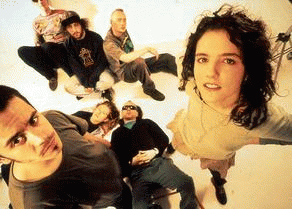 Joe Muggs, 18, festival-goer: One of my most vivid and favourite festival moments ever was the full-on-crusties-in-army-boots moshpit in belting sunshine for [shouty rap-rockers] Senser (pictured left), who were the second act of the day on the NME Stage [at 11.50 AM!]. Then they went off and Andy Kershaw came on to play records. The first tune he played was Primal Scream’s “Don't Fight it Feel It”, and I watched as the entire crowd simultaneously took a breath to whistle along to the main riff, then realised their lips were too dry and just went, “Fwooooff”, en masse, and cracked up laughing.
Joe Muggs, 18, festival-goer: One of my most vivid and favourite festival moments ever was the full-on-crusties-in-army-boots moshpit in belting sunshine for [shouty rap-rockers] Senser (pictured left), who were the second act of the day on the NME Stage [at 11.50 AM!]. Then they went off and Andy Kershaw came on to play records. The first tune he played was Primal Scream’s “Don't Fight it Feel It”, and I watched as the entire crowd simultaneously took a breath to whistle along to the main riff, then realised their lips were too dry and just went, “Fwooooff”, en masse, and cracked up laughing.
Ben Graham, 21, litter-picker: We smoked some grass and, after a bit, went to see [passably successful indie-punkers] Senseless Things on the Pyramid Stage. It was too hot and I was tired, so went back to our tent for a lie down, buying two litres of scrumpy on the way off a guy selling it in our field.
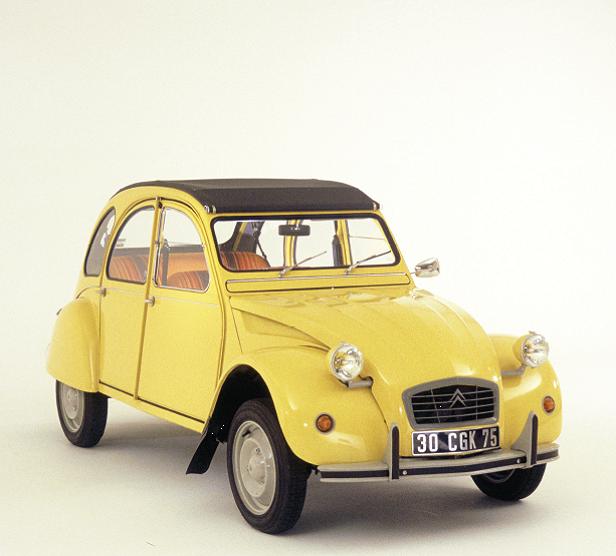 Liz Eliot, 51, Green Fields co-ordinator: Our site vehicles were two battered yellow 2CVs that had miserably failed their MOTs. There was a wonderful mechanic called Amy, a beautiful woman who used to service these vehicles on site. On one occasion I had to visit a field manager with the gears sticking - I had to keep it in second and not change it. Afterwards, they had to physically turn me around as I had no reverse. Then Amy fixed it with a paper clip.
Liz Eliot, 51, Green Fields co-ordinator: Our site vehicles were two battered yellow 2CVs that had miserably failed their MOTs. There was a wonderful mechanic called Amy, a beautiful woman who used to service these vehicles on site. On one occasion I had to visit a field manager with the gears sticking - I had to keep it in second and not change it. Afterwards, they had to physically turn me around as I had no reverse. Then Amy fixed it with a paper clip.
Joe Louis Walker, 41, blues guitarist (1.30 PM, Jazz Stage): I was on Demon Records then and had a seven-piece band. Before we played, they had these young ladies who, I think, volunteered to do the catering. I’m very particular about what I eat. I have to be because I'm a diabetic. Some of the guys rushed and ate. I just looked at the food and said, “Hey, man, if there's stuff with milk or eggs in, when it sits in the sun, you better be careful.” But the drummer and one of the horn players were just greasing - potato salad and coleslaw. After a well-received set we had to drive to Brighton for an evening gig. We hadn't driven an hour and a half when, “Can you stop over there?” Those two had Montezuma's Revenge something serious, that stuff was really coming up.
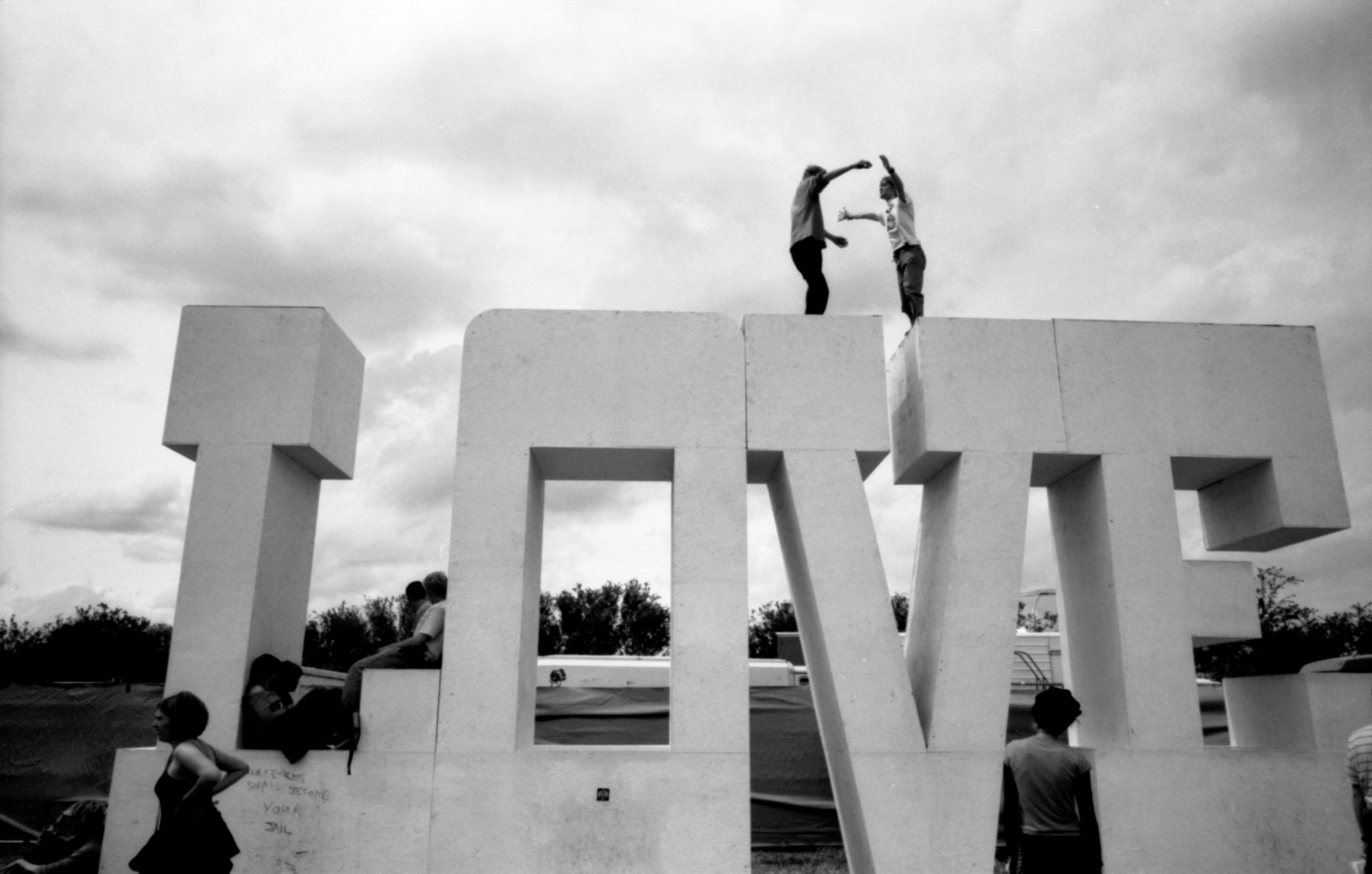 Pat Corley, 39, festival-goer and book-seller: The Hare Krishna tent was just down from us and the queue for their free grub got longer every day as people’s money ran out. We never ate their food, though. Me and Kim, my partner, used to like going to the Wise Crone Café in the Field of Avalon which used to have music on, as well as nice food. Kim really liked the Tiny Tea Tent as well, which is still going to this day.
Pat Corley, 39, festival-goer and book-seller: The Hare Krishna tent was just down from us and the queue for their free grub got longer every day as people’s money ran out. We never ate their food, though. Me and Kim, my partner, used to like going to the Wise Crone Café in the Field of Avalon which used to have music on, as well as nice food. Kim really liked the Tiny Tea Tent as well, which is still going to this day.
Eve Polycarpou, 37, Donna & Kebab (Outside Theatre and other stages, all three days): The Donna & Kebab show was to do with our culture, being second generation Greek-Cypriot, songs and sketches, all the quirks and expectations our families had, and the stereotypical image that non-Greeks had. We did a sketch where we brought someone on stage and taught them how to be a good Greek man.
Martha D Lewis, 29, Donna & Kebab (Outside Theatre and other stages, all three days): We were riding high, doing a fair amount of TV and radio, but I remember thinking we’d finally made it when we had access to Glastonbury Theatre Field’s private artists’ toilets and exclusive dining area!
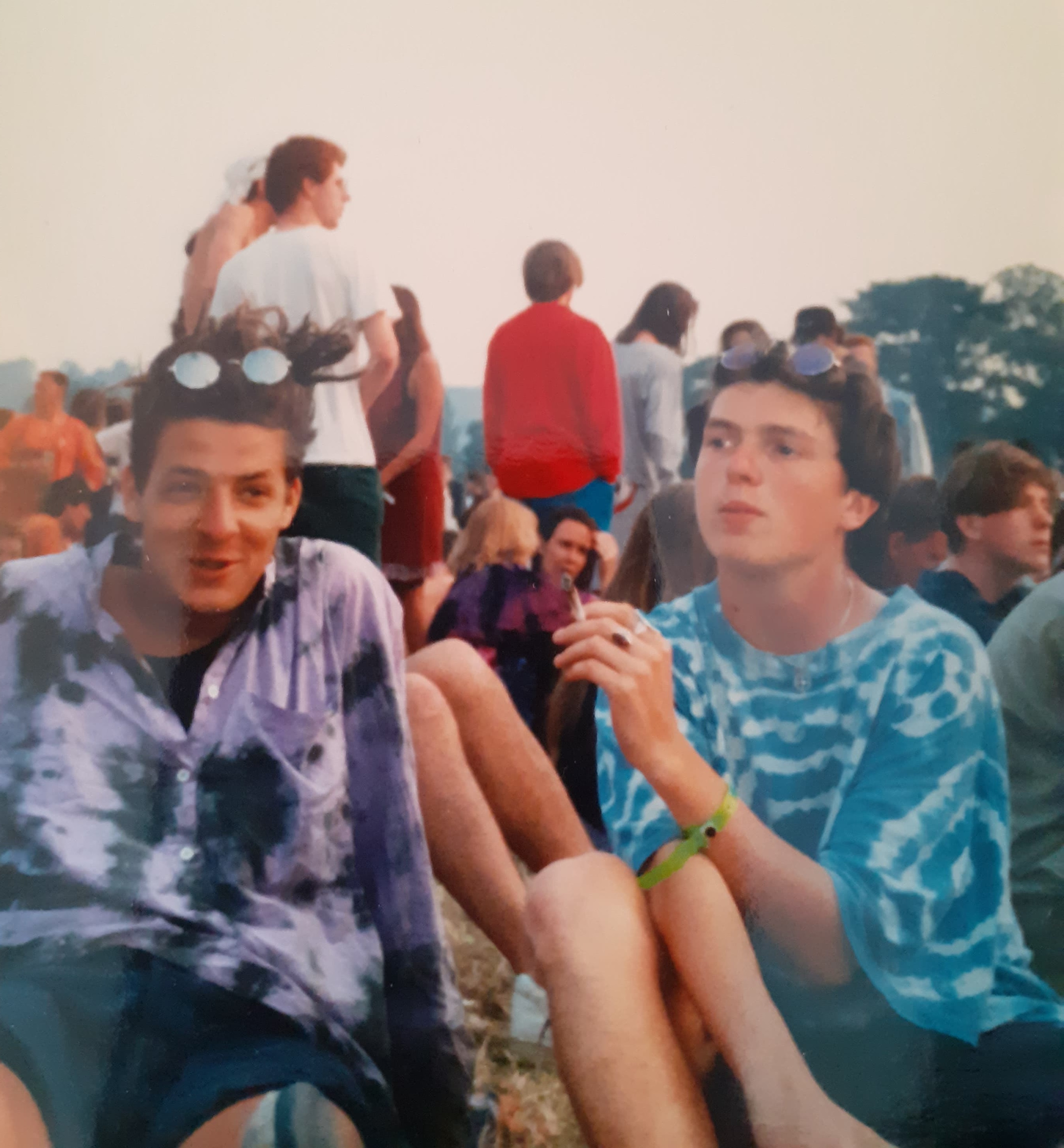 Rowan Chapman, 18, festival-goer: We found the cider bus, skinned up and spent a hazy day slowly frying our minds while the sun fried our skin. Eventually we thought we should take in some music, although I think it’s important to point out, we would of all happily stayed sitting next to the cider bus all weekend.
Rowan Chapman, 18, festival-goer: We found the cider bus, skinned up and spent a hazy day slowly frying our minds while the sun fried our skin. Eventually we thought we should take in some music, although I think it’s important to point out, we would of all happily stayed sitting next to the cider bus all weekend.
Liz Eliot, 51, Green Fields co-ordinator: The Green Fields was mostly acoustic and there was no alcohol, apart from the occasional stall selling brandy hot chocolate, and The Dog and Vomit café which did weird things and sold beer.
Russell Hiscox, 16, Festival-goer: [Bristol post-punkers] The Blue Aeroplanes, on the Pyramid in the late afternoon, had the craziest dancer onstage - he could outdance Bez!
Pat Corley, 39, festival-goer and book-seller: Across the walkway from us were some Australian girls selling hats which they had made themselves. Some of the hats were really tall and others were like jester’s hats. They did a roaring trade and those types of hat became very popular at Glastonbury over succeeding years. You needed a hat in ‘92 because it was so hot. I bought one to keep the sun off my head, not from the Aussies but from another stall. It was a nice hippy-type hat. The sort of thing a Mongolian goatherd might wear. I only had it about two days, though. Passing a water-point, I thought I’d stick my head under the tap to cool off and I put my hat down for just a minute. When I turned around it had disappeared. The scallies had likely made off with it. They were becoming a noticeable presence at the festival.
 Caspar Gomez, 24, festival-goer: Friday afternoon-into-evening was a great NME Stage run of bands who’d adopted druggy dance music stylings; loping beats and the 'Funky Drummer' groove. Moonflowers were on in the afternoon, an enjoyably chaotic show that reeked of hash smoke, featuring Bristol hippies in shorts, a digderidoo, and a dancer with a Residents-style eyeball head who looked like Federation Ambassador Alpha Centauri from 1970s Doctor Who. Later on, London’s brief baggy kings Flowered Up laid down a staunch set that had me doobie-dancing topless in the late afternoon sun. They played their era-encapsulating 15 minute monster “Weekender”, then only a couple of months old, and still one of the best snapshoots of those E-addled times, and I swayed about to a new one I didn’t recognise, a dubbed out, brassy gem. I recall thinking, “This bodes well for their future,” but it eventually turned up, two years of radio silence later, as their swan song release, “Better Days”.
Caspar Gomez, 24, festival-goer: Friday afternoon-into-evening was a great NME Stage run of bands who’d adopted druggy dance music stylings; loping beats and the 'Funky Drummer' groove. Moonflowers were on in the afternoon, an enjoyably chaotic show that reeked of hash smoke, featuring Bristol hippies in shorts, a digderidoo, and a dancer with a Residents-style eyeball head who looked like Federation Ambassador Alpha Centauri from 1970s Doctor Who. Later on, London’s brief baggy kings Flowered Up laid down a staunch set that had me doobie-dancing topless in the late afternoon sun. They played their era-encapsulating 15 minute monster “Weekender”, then only a couple of months old, and still one of the best snapshoots of those E-addled times, and I swayed about to a new one I didn’t recognise, a dubbed out, brassy gem. I recall thinking, “This bodes well for their future,” but it eventually turned up, two years of radio silence later, as their swan song release, “Better Days”.
Sean O'Neil, 26, Moonflowers (2.00 PM, NME Stage): Our set was a moment of celebration, a happening, a coming together. We were joined by singer Angie Stewart, Francis [Kane] George [Claridge] & Paul [Bradley] from The Me Band, and the brass section from Bristol space jazzers Spaceways, Adam Clarkson on didgeridoo, and the dancing talents of Simon Thingy. We were mid-tour, on our way to Czechoslovakia on Sunday. It felt pretty wild, a free-range performance channelling a strong positive vibration in collaboration with the audience. It was for peace and unity and we were together. On a personal level, I’d been up for a couple of days drifting through psycodelic pairsiutes [sic]. I tried to get some rest before the performance but my tent was redesigned in my absence and not a place to rest. Finding myself onstage, there was nothing to hang on to except the music and the love.
Below: Shonky but atmospheric footage of Moonflowers performing at Glastonbury Festival 1992
Joe Muggs, 18, festival-goer: Jah Wobble came on for his NME Stage encore having done a quick change of clothes, wearing a jacket that looked like it was white silk, and saying something along the lines of, “There you go, worth £90 admission to get a glimpse of the clobber”.
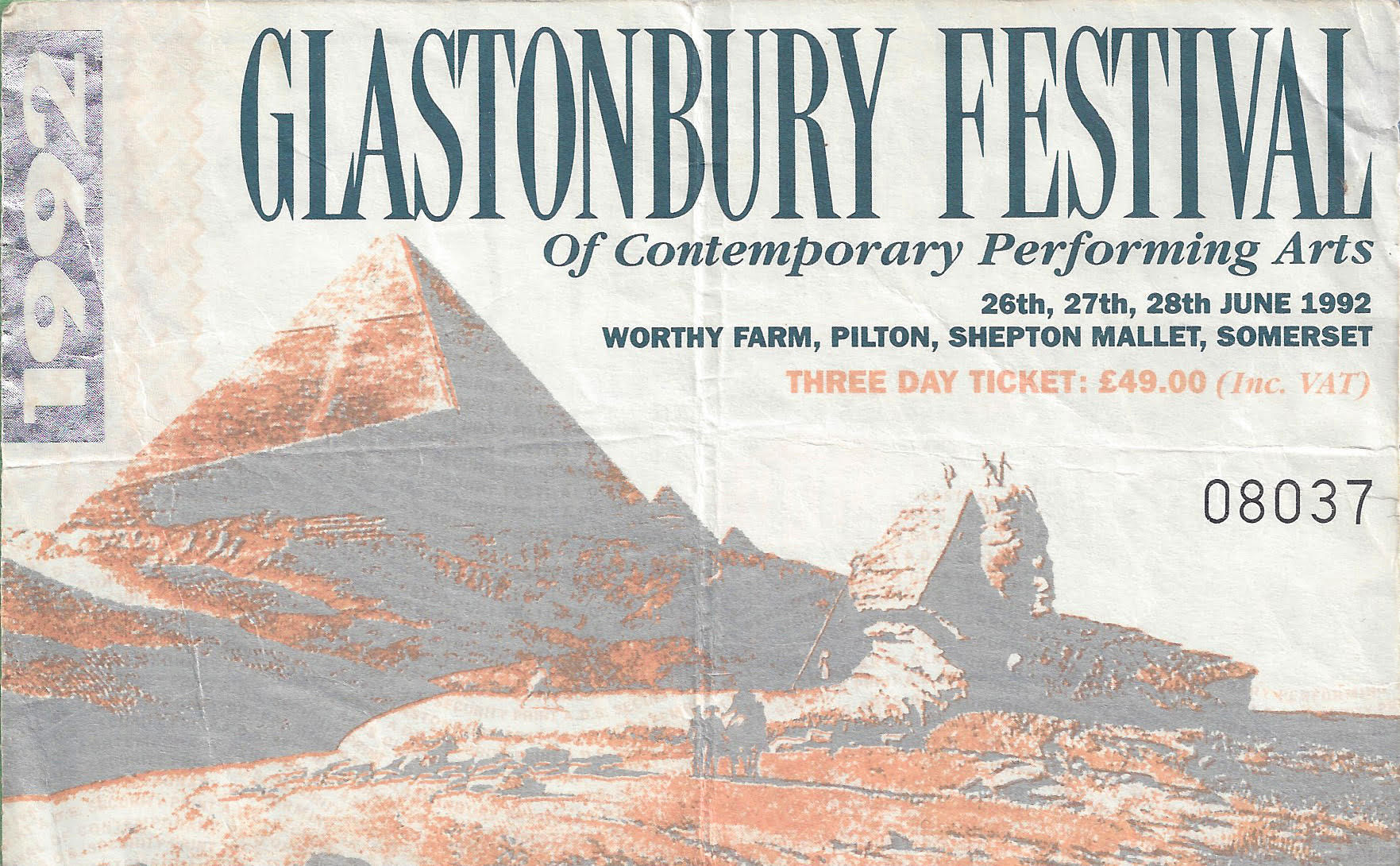 Rowan Chapman, 18, festival-goer: I remember a perfect moment in the early evening when Jah Wobble was playing and Sinead O’Connor joined him to sing “Visions of You”. Her voice seemed so angelic, floating though the warm, balmy air and touching our souls. This wasn’t just a music festival, it was something more. I knew we would never be the same again.
Rowan Chapman, 18, festival-goer: I remember a perfect moment in the early evening when Jah Wobble was playing and Sinead O’Connor joined him to sing “Visions of You”. Her voice seemed so angelic, floating though the warm, balmy air and touching our souls. This wasn’t just a music festival, it was something more. I knew we would never be the same again.
Stefan Linne, 31, Sheinbar Varieté (Circus Big Top all three days): Friday evening was the final of the European Football Championship. Germany was playing against Denmark so we watched the game in the backstage area. All the English guys were on Denmark’s side [Denmark won 2 – 0].
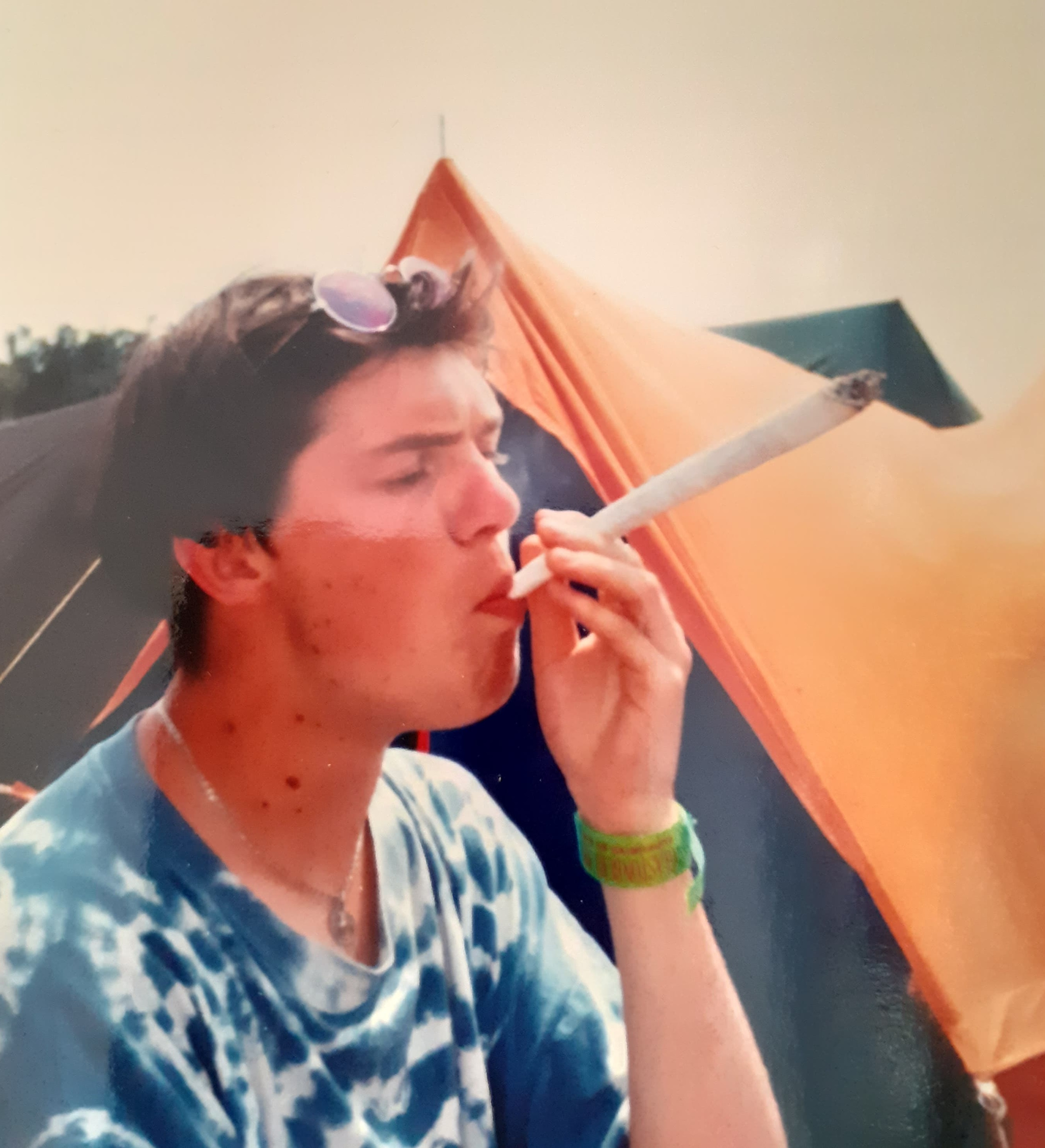 Rowan Chapman, 18, festival-goer: In 1992, rave culture and traveller culture were right at the forefront of everything. It was a year when traveller/crusty culture almost became fashionable and bands like Back To The Planet were gaining popularity. It seems like a lifetime ago. There were a lot of dreadlocks, a lot of ecstasy and a lot of acid. Everyone seemed to be offering microdots. The Orb were playing the NME Stage and this seemed a good place to try acid for first time for many of us. Unfortunately, there were also a lot of people selling duds to naive, middle class teenagers from Surrey. Friday afternoon became Russian Roulette for taking a trip. Some of us got lucky, some of us got unlucky, and one of my friends was too impatient, thinking he’d been sold a dud, so bought another and had a double dose. His brain is still somewhere in that field, down in Pilton.
Rowan Chapman, 18, festival-goer: In 1992, rave culture and traveller culture were right at the forefront of everything. It was a year when traveller/crusty culture almost became fashionable and bands like Back To The Planet were gaining popularity. It seems like a lifetime ago. There were a lot of dreadlocks, a lot of ecstasy and a lot of acid. Everyone seemed to be offering microdots. The Orb were playing the NME Stage and this seemed a good place to try acid for first time for many of us. Unfortunately, there were also a lot of people selling duds to naive, middle class teenagers from Surrey. Friday afternoon became Russian Roulette for taking a trip. Some of us got lucky, some of us got unlucky, and one of my friends was too impatient, thinking he’d been sold a dud, so bought another and had a double dose. His brain is still somewhere in that field, down in Pilton.
Andrew Harrison, 25, Select Magazine Editor: Before The Orb came on I can remember them playing an astonishing tune which I didn't really recognise but now know was “E2-E4” by Manuel Göttsching, the original version not the Sueño Latino sampled version. The Orb played this before they came on. It was such a massively long extended intro and the whole crowd was grinding its teeth ready to go absolutely mental. It was just thrilling.
Bobby Gillespie, 30, Primal Scream (11.00 PM, NME Stage): Backstage before the gig, it was a lovely summer evening, and Peter Hook from New Order had driven down to see us, his Range Rover parked up next to the tour bus. He was hanging out with us and Peter Gabriel passed with Sinead O'Connor. I remember thinking, “What's the dynamic there?”
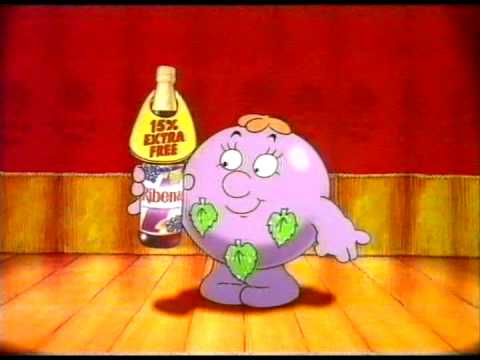 Alex Patterson, 32, The Orb (9.30 PM, NME Stage): I arrived at Glastonbury and everything was fine. Me and a close friend at the time, Roger, decided to find the KLF Winnebago to see how Jimmy [Cauty] and the KLF crew were getting on. We found the Winnebago but they weren’t there. We were a bit parched so we raided their fridge of some Ribena. We downed the whole lot in the afternoon. Little did we know we’d spiked ourselves as this was infused with their drug of choice for weekend; liquid Ecstasy. Roger was one of those people that just you didn't contemplate doing drugs with. He was in his own world anyway. Next thing I know I've ended up with a paramedic in a field, screaming, "I found him," and yelling out the name of some girl who wasn’t my girlfriend. Then I recall is being being wheeled on stage for The Orb gig. All I can remember from that is Steven Hillage’s teeth. Steve Hillage has some fine teeth on him and they were just shining in the light.
Alex Patterson, 32, The Orb (9.30 PM, NME Stage): I arrived at Glastonbury and everything was fine. Me and a close friend at the time, Roger, decided to find the KLF Winnebago to see how Jimmy [Cauty] and the KLF crew were getting on. We found the Winnebago but they weren’t there. We were a bit parched so we raided their fridge of some Ribena. We downed the whole lot in the afternoon. Little did we know we’d spiked ourselves as this was infused with their drug of choice for weekend; liquid Ecstasy. Roger was one of those people that just you didn't contemplate doing drugs with. He was in his own world anyway. Next thing I know I've ended up with a paramedic in a field, screaming, "I found him," and yelling out the name of some girl who wasn’t my girlfriend. Then I recall is being being wheeled on stage for The Orb gig. All I can remember from that is Steven Hillage’s teeth. Steve Hillage has some fine teeth on him and they were just shining in the light.
Ben Graham, 21, litter-picker: At first [veteran New York proto-post-punk band] Television, who were on the Pyramid, sounded just alright, but also like all the bands they influenced: the House of Love here, Lloyd Cole and the Commotions there. But then the spliffs and the scrumpy kicked in and things improved vastly, those intertwining, chiming guitar lines doing my head in. Then we went up to the NME Stage to watch The Orb, who were riveting for about five minutes and then totally boring for the next eight weeks or however long they played. Then Primal Scream, who were pretty great, although we were crushed between yobbish ravers, blocking our view. We were also falling asleep on our feet.
 Rosie the Riveter, 17, festival-goer: I had a very short DIY pink haircut and was wearing pink dungarees. I bought a lighter off a bloke and when he gave me my change he said, “There you go sonny,” which in less gender-fluid times I found odd. It was hot as hell every day. No mud. I was at the front for Primal Scream at the NME Stage, skinning up on the barrier before they came on. A lady representing the BBC came over and asked me to stop as it was hampering their filming.
Rosie the Riveter, 17, festival-goer: I had a very short DIY pink haircut and was wearing pink dungarees. I bought a lighter off a bloke and when he gave me my change he said, “There you go sonny,” which in less gender-fluid times I found odd. It was hot as hell every day. No mud. I was at the front for Primal Scream at the NME Stage, skinning up on the barrier before they came on. A lady representing the BBC came over and asked me to stop as it was hampering their filming.
Bobby Gillespie, 30, Primal Scream (11.00 PM, NME Stage): Screamdelica was released in September '91 so it had been in the culture for nine months. When we played the show on the second stage, we hadn’t played any gigs in Britain since the Screamdelica Tour the previous autumn. It was the biggest crowd we’d ever played.
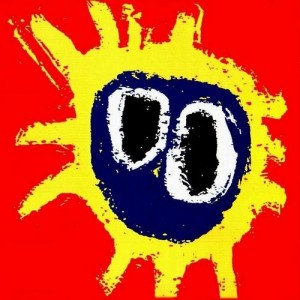 Russell Hiscox, 16, Festival-goer: Primal Scream kept the crowd waiting for ages before they took to the stage. The crowd became agitated and started shouting out things like, “Where are you Bobby, you golden lamé ?” Bobby Gillespie was very partial to gold lamé shirts at that point in his career.
Russell Hiscox, 16, Festival-goer: Primal Scream kept the crowd waiting for ages before they took to the stage. The crowd became agitated and started shouting out things like, “Where are you Bobby, you golden lamé ?” Bobby Gillespie was very partial to gold lamé shirts at that point in his career.
Bobby Gillespie, 30, Primal Scream (11.00 PM, NME Stage): I sat down during some songs. The reason I did was that [Screamadelica’s songs] weren’t structured like regular high energy rock or pop songs with, like, guitar intro, eight bars, four bar chorus, guitar solo; some of them were eight or nine minutes long, with four minute instrumental sections. Sometimes I just sat on the edge of the stage, and clapped, looked at the audience. That was stage craft, you know, it wasn't that I was too wasted to stand.
 Alex Patterson, 32, The Orb (9.30 PM, NME Stage): Primal Scream (pictured left, live at Glastonbury '92) invited me to do a version of [The Stooges’] “No Fun”, which I used to do as a kid with Killing Joke. I was no stranger to the song, but I was still completely titted from earlier. I hid under the drum riser to sing it. Because I was an ex-drum roadie, it seemed logical at the time, but Bobby Gillespie couldn't find me or where the singing was coming from.
Alex Patterson, 32, The Orb (9.30 PM, NME Stage): Primal Scream (pictured left, live at Glastonbury '92) invited me to do a version of [The Stooges’] “No Fun”, which I used to do as a kid with Killing Joke. I was no stranger to the song, but I was still completely titted from earlier. I hid under the drum riser to sing it. Because I was an ex-drum roadie, it seemed logical at the time, but Bobby Gillespie couldn't find me or where the singing was coming from.
Joe Muggs, 18, festival-goer: It’s all fragmented as fuck, but I remember having some dayglo pink strawberry king skins, so we'd roll big pink joints, then tear off the sticky strip from standard Rizlas and wrap them around in a spiral. We were smoking candy-stripe spliffs the whole time.
Martha D Lewis, 29, Donna & Kebab (Outside Theatre and other stages, all three days): You had no control over the noise levels of children. I thought, actually, the children should be banned! But the evening shows were definitely more out of control, not from the kids – by that time adult drunkenness had taken over.
Tony Cordy, 35, Green Lights Oasis director: 1992 was the last year that I oversaw what subsequently became the Greenpeace Field. We were the naughty corner, running 24 hours a day. I was sort of keeping an eye on the Green Kids Area, which is at the very back of that field by the big oak tree, but mostly running this venue, the Green Lights Oasis. We had this amazing backdrop and proscenium. A mate of mine, a guy called Wads [Paul Wadsworth], quite a famous artist now in Cornwall, painted this whole Yellow Brick Road set. We put on bands and other craziness but were also committed to doing very environmentally friendly, organically sourced, really cheap food, all served on crockery, which was absolute madness. I think we were doing 5000 meals a day.
 Angela B, 18, festival-goer: It was the first time I’d ever heard [US ska-punkers] Fishbone (pictured right) and they just blew my mind. They were on the Pyramid Stage and the sun was shining. We’d had a few big spliffs and the brass section was gleaming in the sunshine. They sounded so brilliant and exciting. We didn’t end up seeing anyone we’d travelled down with all weekend, but this set just kind of made up for everything that had happened.
Angela B, 18, festival-goer: It was the first time I’d ever heard [US ska-punkers] Fishbone (pictured right) and they just blew my mind. They were on the Pyramid Stage and the sun was shining. We’d had a few big spliffs and the brass section was gleaming in the sunshine. They sounded so brilliant and exciting. We didn’t end up seeing anyone we’d travelled down with all weekend, but this set just kind of made up for everything that had happened.
Ben Graham, 21, litter-picker: We were so knackered, it was straight to bed after Primal Scream. Except it wasn’t, because on the way we passed Dogs of Heaven, the Manchester performance art outfit, in the Fire Field. All manner of strangeness was going on. They were acting out some drama involving a giant dragon, lots of people covered in body paint and riot police on stilts.
Kevin Geraghty-Shewan, 30, festival-goer: I wandered to the Pyramid stage to see Carter the Unstoppable Sex Machine. Either side of the stage were video walls which the techies had spent all day setting up - and they still weren't working. This amused me greatly as I work in the presentations industry. Curiously, I would later employ the person responsible for this cock up!
Jim Bob, 30, Carter the Unstoppable Sex Machine, (11.00 PM, Pyramid): I can’t remember whose idea it was to fire five thousand foam tennis balls with the name of our new single, “Do Re Me So Far So Good” into the audience but it must have seemed like a good one at the time. We had originally wanted to drop them from two helicopters but we couldn’t get clearance from Air Traffic Control. So we had these huge cannons loaded with the foam balls either side of the stage. When we played “Do Re Me” as an encore the cannons would do their thing. Unfortunately, the stage was massively over-running and we were asked to cut our set short. We must have moved the song up the set because we did manage to cover Glastonbury in foam balls. You can still buy them on eBay. Select magazine slagged us off for ruining the festival’s Greenpeace credentials with our toxic tennis balls.
Below: Listen to Carter the Unstoppable Sex Machine play "Sheriff Fatman" live at Glastonbury Festival 1992
Jim Bob, 30, Carter the Unstoppable Sex Machine, (11.00 PM, Pyramid): We couldn’t play our full planned set. This led to arguments between us and the stage manager. As a compromise it was decided that Fruitbat would go on stage, thank everyone for coming and apologise for the foreshortened set. Instead, Fruitbat slagged off pretty much everything about Glastonbury and dropped the mic. More backstage arguments followed, including a visit to the dressing room from a livid Michael Eavis and we were asked to leave the site. Other than that, my clearest abiding memory of Glastonbury 1992 is of it being incredibly dusty and that we arrived in a fleet of open-topped Jeeps.
Eve Polycarpou, 37, Donna & Kebab (Outside Theatre and other stages, all three days): At the end of the night, after performing, it was celebration time, before we went to sleep, sitting outside the tent smoking and gently jamming with others.
Liz Eliot, 51, Green Fields co-ordinator: We had the drumming in those days at the Stone Circle, which was a bit of a nightmare at night, but only because local farmers would complain.
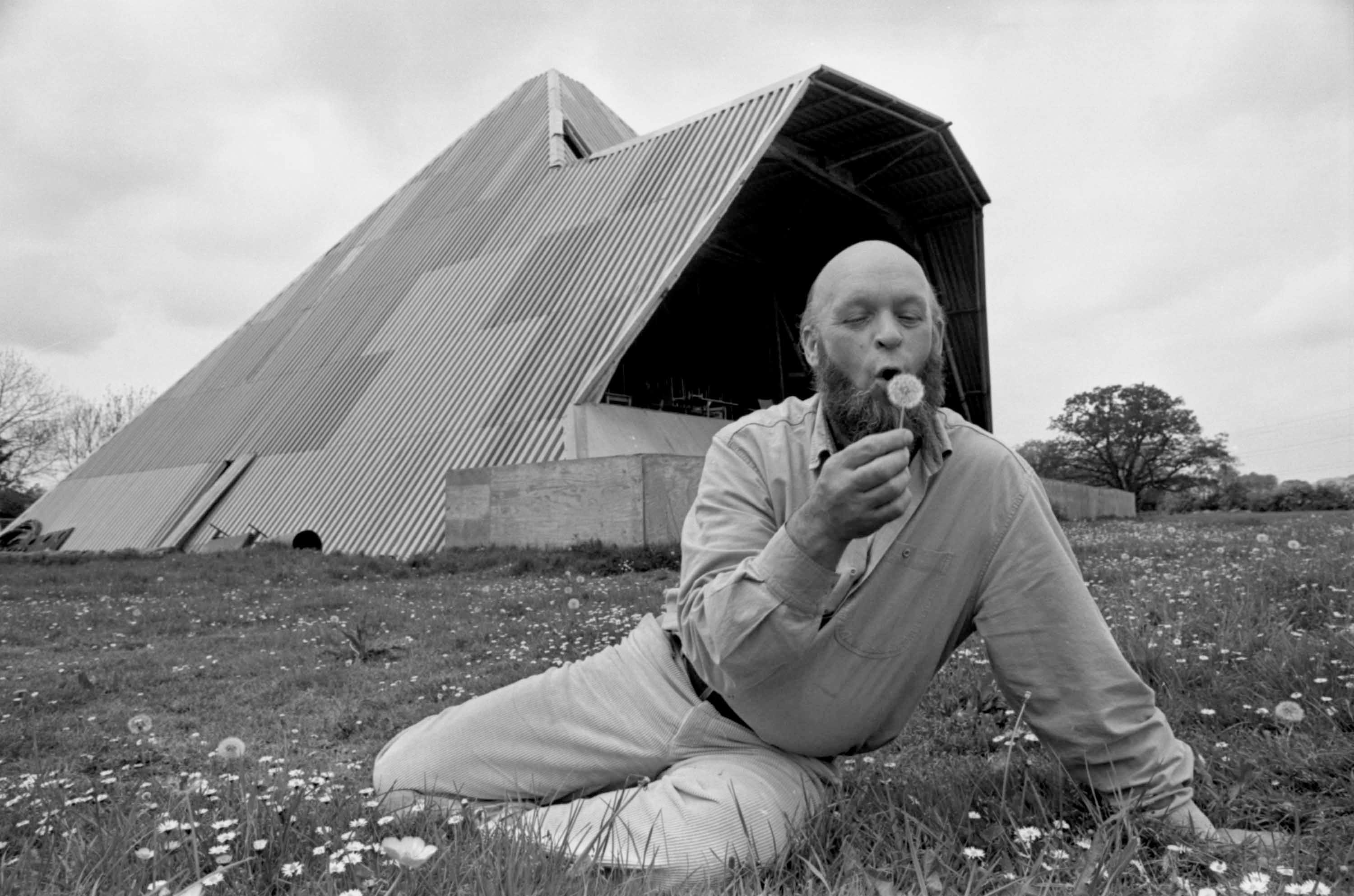 Steve Bedlam, 20, Bedlam Sound System: One of my lasting memories is everyone using the bushes to piss in and the rest. Michael Eavis walked out, came up to the sound system, gave us a bunch of wristbands. and said, “Stop using the hedges as a toilet - come and use the toilets inside the festival.” That was first time I ever met him.
Steve Bedlam, 20, Bedlam Sound System: One of my lasting memories is everyone using the bushes to piss in and the rest. Michael Eavis walked out, came up to the sound system, gave us a bunch of wristbands. and said, “Stop using the hedges as a toilet - come and use the toilets inside the festival.” That was first time I ever met him.
Caspar Gomez, 24, festival-goer: Arriving back at the tent as the sun was rising, I could hear a tune billowing across the site from some sound system over  Glastonbury. A figure with dreadlocks by a hedge in our field was dancing to it, eyes closed. The juddering synth chords were contagious. I noticed this tune reappear all weekend, a sassy change from the battering hardcore that was de rigeur in my world at the time. It turned out to be “Don’t You Want Me’ by Felix, which was circulating on white label and would later be a proper hit, launching the careers of its remixers, Rollo, of Faithless and Dido fame, and Red Jerry, whose Hooj Choons label would rule mid/late-Nineties dancefloors.
Glastonbury. A figure with dreadlocks by a hedge in our field was dancing to it, eyes closed. The juddering synth chords were contagious. I noticed this tune reappear all weekend, a sassy change from the battering hardcore that was de rigeur in my world at the time. It turned out to be “Don’t You Want Me’ by Felix, which was circulating on white label and would later be a proper hit, launching the careers of its remixers, Rollo, of Faithless and Dido fame, and Red Jerry, whose Hooj Choons label would rule mid/late-Nineties dancefloors.
Tony Andrews, 42, Funktion-One sound system don: By ’92 we’d passed the main stage sound on to [audio equipment rental company] Britannia Row and I asked if we could set up the Experimental Sound Field [which led to] the scariest night of my life. They had 8000 people there, it was all going off, and literally our lives were being threatened. [At one point] we had Underworld and Darren Emerson on and we were running over but it was way too dangerous to turn it off. We wouldn’t have got out alive.
Graham Sugarlump, 32, Sugarlump Sound System: Tony Andrews basically invented turbo sound and he was overseeing the Experimental Sound Field. He had a quadrophonic four stack system. He was meant to be there, totally legal, so he had to abide by all the regulations about size of sound system and what time to shut down. It was an installation more than a party. Allegedly a rave crew kidnapped him and held him hostage in his car. They took over and played hardcore gabber. Then they came down to Sugarlump the following night, trying to do the same thing, but they realised we were totally illegal and were, like, “You guys just carry on, we’ll take our records somewhere else.”
Below: Shonky but atmospheric footage of Sugarlump Sound System at Glastonbury Festival 1992
SATURDAY 27th JUNE
William Potter, 27, CUD (5.15 PM NME Stage): It was a blazing hot, bogless year of fractal-patterned vests, sandals and scorched necks. We joined the traffic jam of pilgrims headed to the site on the Saturday. It took 90 minutes to reach the VIP area of the NME stage where Gene October from [original Seventies London punks] Chelsea invaded our portacabin to poach beer, unfazed by the fact we didn’t know who he was.
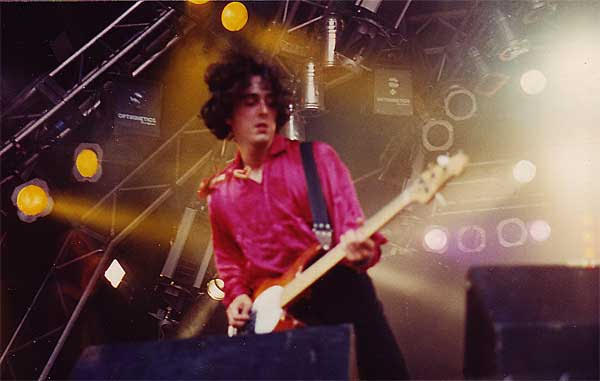 Ben Graham, 21, litter-picker: A hard morning picking, lots of litter, lots of people giving us a hard time and lots of heat, so we didn’t finish early and I missed Liverpudlian garage rockers, The Stairs on the NME Stage, who I really wanted to see. Just caught the end of Th’ Faith Healers’ set, then agit-prop dub monsters RDF [Radical Dance Faction], who were really good, even though they suffered from the lack of their female vocalist. I think they might have stepped in for The Sandkings who were on the line-up but didn’t play as they’d just split up. Next up were [quirky Leeds indie band] CUD (pictured above left and below right at Glastonbury 1992), who were brilliant. They were being very silly and the vibes were good.
Ben Graham, 21, litter-picker: A hard morning picking, lots of litter, lots of people giving us a hard time and lots of heat, so we didn’t finish early and I missed Liverpudlian garage rockers, The Stairs on the NME Stage, who I really wanted to see. Just caught the end of Th’ Faith Healers’ set, then agit-prop dub monsters RDF [Radical Dance Faction], who were really good, even though they suffered from the lack of their female vocalist. I think they might have stepped in for The Sandkings who were on the line-up but didn’t play as they’d just split up. Next up were [quirky Leeds indie band] CUD (pictured above left and below right at Glastonbury 1992), who were brilliant. They were being very silly and the vibes were good.
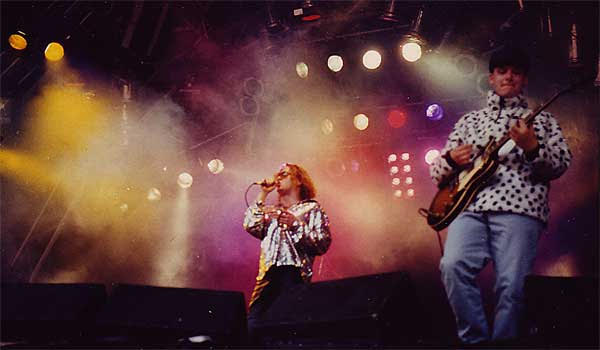 William Potter, 27, CUD (5.15 PM NME Stage): 1992 and CUD were peaking, fresh from a Top 30 hit, and US tour, galvanised to be playing Glastonbury for the first time. We were on stage at the end of the afternoon but it was late enough for lighting. Carl [Puttnam, singer] had a quick chat with John Peel side-stage, we got a brief line check, then shimmied in our spangly shirts in front of an ocean of faces. There were no cameras and stage-side screens in ‘92; I bounced as far as my bass lead would reach to cover ground and lean over the stage edge. The Drummer-from-CUD dropped a stick and messed up “Robinson Crusoe”. A misreading of the set-list led to an audible argument between singer Carl and guitarist Mike, but it raised a cheer. Barely controlled, over too soon, a bucket-list goal achieved. The crowd danced and formed human pyramids. The sun blazed. It was a blast. Afterwards I caught Lou Reed actually playing the hits and Shakespears Sister and rued the fact our manager had sited us in a dreary hotel out of earshot of Worthy Farm.
William Potter, 27, CUD (5.15 PM NME Stage): 1992 and CUD were peaking, fresh from a Top 30 hit, and US tour, galvanised to be playing Glastonbury for the first time. We were on stage at the end of the afternoon but it was late enough for lighting. Carl [Puttnam, singer] had a quick chat with John Peel side-stage, we got a brief line check, then shimmied in our spangly shirts in front of an ocean of faces. There were no cameras and stage-side screens in ‘92; I bounced as far as my bass lead would reach to cover ground and lean over the stage edge. The Drummer-from-CUD dropped a stick and messed up “Robinson Crusoe”. A misreading of the set-list led to an audible argument between singer Carl and guitarist Mike, but it raised a cheer. Barely controlled, over too soon, a bucket-list goal achieved. The crowd danced and formed human pyramids. The sun blazed. It was a blast. Afterwards I caught Lou Reed actually playing the hits and Shakespears Sister and rued the fact our manager had sited us in a dreary hotel out of earshot of Worthy Farm.
Below: Shonky but atmospheric handheld footage of CUD performing at Glastonbury Festival 1992
Pat Corley, 39, festival-goer and book-seller: I had my books all displayed nicely and priced up. Kim was amazed at how well they sold. Then my friend Dave, who, like me, has been going to Glastonbury since 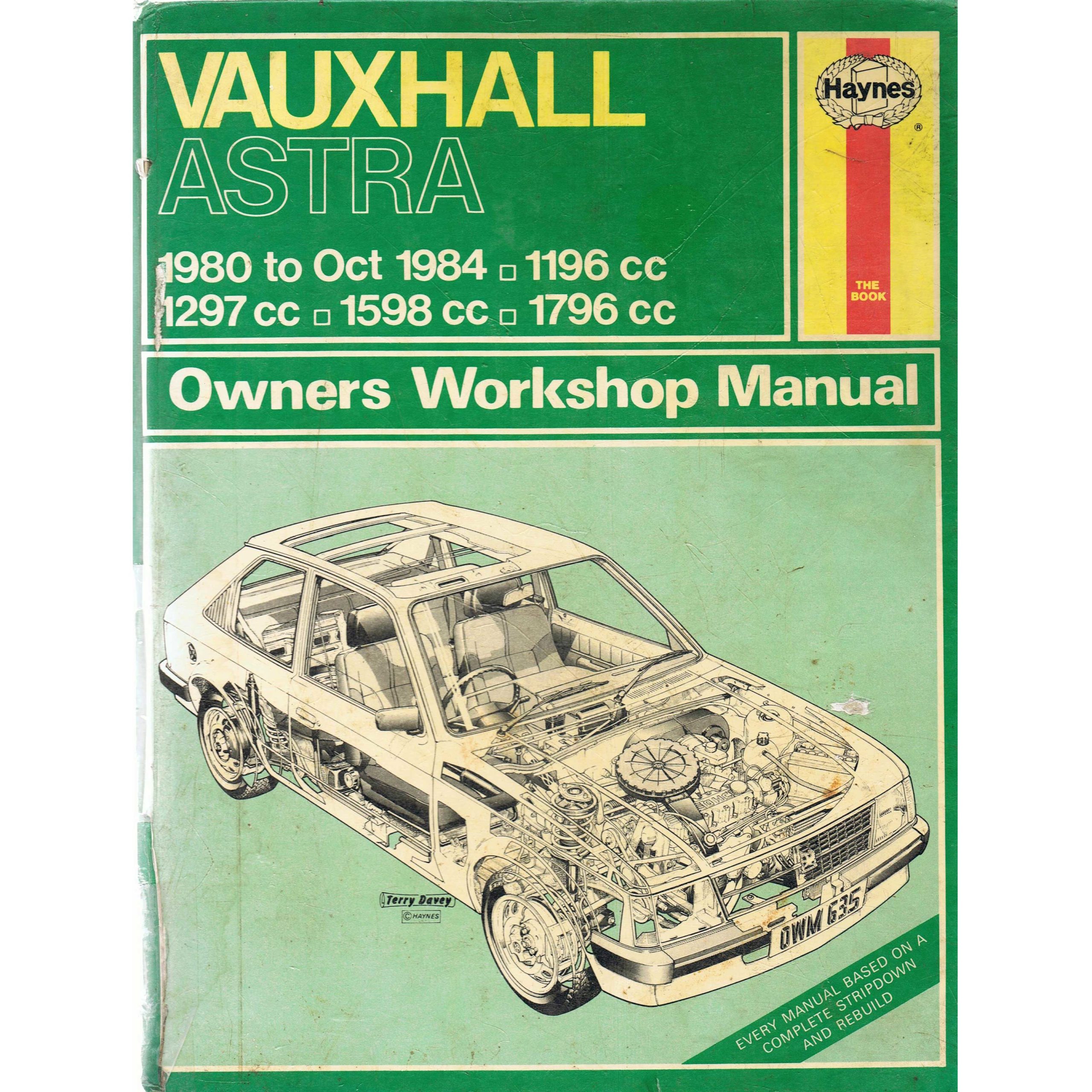 1979, decided to get in on the act. He had brought along two bin-bags of books of much inferior quality to mine. Things like Haynes Car Manuals which he proceeded to tip out all over my stall and started shouting, “Any book, 50 pence!”. I had to nip that in the bud pronto and made him flog his wares a few yards away.
1979, decided to get in on the act. He had brought along two bin-bags of books of much inferior quality to mine. Things like Haynes Car Manuals which he proceeded to tip out all over my stall and started shouting, “Any book, 50 pence!”. I had to nip that in the bud pronto and made him flog his wares a few yards away.
Liz Eliot, 51, Green Fields co-ordinator: We had a message, “Can you can you try and find a guy called Spike. His family have called in desperation because his mother has died. He's camped under a tree.” There were trees everywhere, but we found him within 20 minutes. It's just the way it used to operate before modern communications. We had a kind of telepathic zoning in, intuitively.
Stefan Linne, 31, Sheinbar Varieté (Circus Big Top, all three days): We’d put together a show about West and East Germany coming together again, based around projected slides of Berlin underground stations. But it didn't work, the English people didn't care. “Come on,” we said, “Nobody is giving a shit about all this Berlin stuff!” It was our first performance in England and we needed to understand the sense of humour. It was edgier than in Germany at that time. We had a sport-themed mime piece where we ran in slow motion through the audience. There were some some kids making annoying noise. My friend Klaus was very muscular and he took two kids, lifted them under his arms and went in slow motion onstage. All the audience were screaming, “Yeah, kill those fucking bastards!” This was the moment I understood. OK, this is the English sense of humour. You can have this, no problem. So I was playing like we were going to slaughter them backstage. From then on, we had no problems.
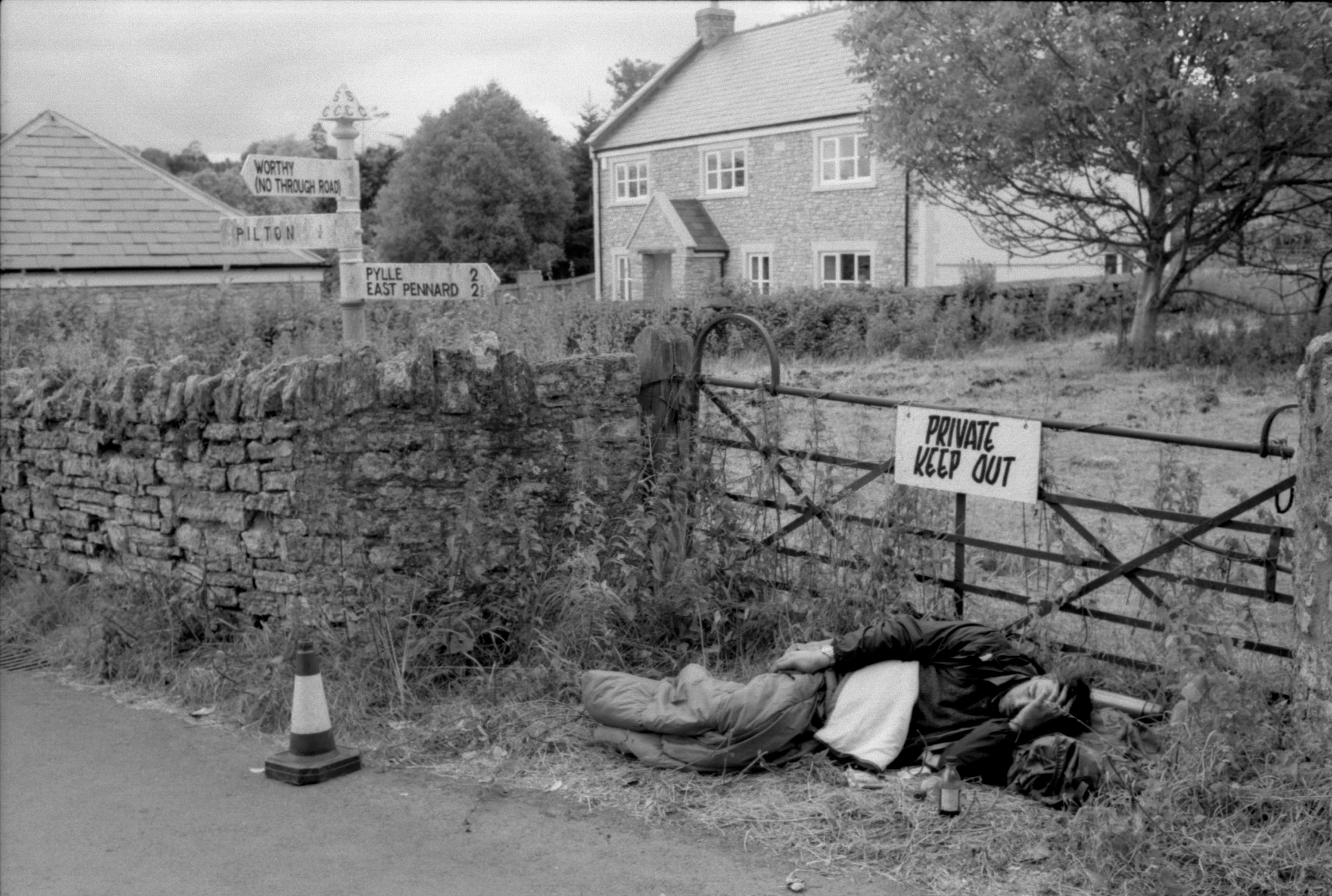 Jane Q, 22, festival-goer: I recall seeing PJ Harvey but, for me, the early Nineties felt like an unsettling time of change for the festival. There was a lot of animosity between security and the travellers who, after 1990, weren’t given a field at the festival or a free pass. It had, until this point, been a stopping place for travellers on the way to Stonehenge for Solstice, but after clashes with security they were no longer welcomed by Eavis and were having their own party outside the fence. For me this was a real bummer as the Travellers Field was where the acid house parties were, and was where, in 1989, I first heard this kind of music and experienced partying all night to acid house on LSD and Ecstasy. There was a peaceful, friendly vibe and I felt welcome. I wasn’t bothered by the main stages, it was what was going on at the fringes, that was where I found myself, that exciting unified feeling. Once the travellers were not allowed in, the vibe of the festival changed a great deal. After 1990 the gap was filled by gangs coming in from towns and cities. For a few years it became a bit dodgy and there was quite a lot of theft and a dark vibe at times.
Jane Q, 22, festival-goer: I recall seeing PJ Harvey but, for me, the early Nineties felt like an unsettling time of change for the festival. There was a lot of animosity between security and the travellers who, after 1990, weren’t given a field at the festival or a free pass. It had, until this point, been a stopping place for travellers on the way to Stonehenge for Solstice, but after clashes with security they were no longer welcomed by Eavis and were having their own party outside the fence. For me this was a real bummer as the Travellers Field was where the acid house parties were, and was where, in 1989, I first heard this kind of music and experienced partying all night to acid house on LSD and Ecstasy. There was a peaceful, friendly vibe and I felt welcome. I wasn’t bothered by the main stages, it was what was going on at the fringes, that was where I found myself, that exciting unified feeling. Once the travellers were not allowed in, the vibe of the festival changed a great deal. After 1990 the gap was filled by gangs coming in from towns and cities. For a few years it became a bit dodgy and there was quite a lot of theft and a dark vibe at times.
 Brian Futter, 28, Catherine Wheel (2.45 PM, NME Stage) (band pictured left): Glastonbury fell smack bang in the middle of our tour of the States. We were to fly home to play Glastonbury, then fly back to the States the next day. To cut a long story short, our flight to the UK was late, then cancelled. By the time we managed to get another flight we were out of time. We tried to get a band called Thousand Yard Stare to swap timeslots with us, but they refused. We ended up getting onstage with five minutes of our slot left. All our gear was hired. I got the wrong amplifier. My guitar sounded like a white noise generator through it. We stumbled onstage, played an unrecognisable mess for five minutes to a sea of confused faces... then stumbled off. It’s probably the angriest any of us have ever been. We flew back to the US the next day, kind of numb. A horrendous experience, and the last thing we wanted.
Brian Futter, 28, Catherine Wheel (2.45 PM, NME Stage) (band pictured left): Glastonbury fell smack bang in the middle of our tour of the States. We were to fly home to play Glastonbury, then fly back to the States the next day. To cut a long story short, our flight to the UK was late, then cancelled. By the time we managed to get another flight we were out of time. We tried to get a band called Thousand Yard Stare to swap timeslots with us, but they refused. We ended up getting onstage with five minutes of our slot left. All our gear was hired. I got the wrong amplifier. My guitar sounded like a white noise generator through it. We stumbled onstage, played an unrecognisable mess for five minutes to a sea of confused faces... then stumbled off. It’s probably the angriest any of us have ever been. We flew back to the US the next day, kind of numb. A horrendous experience, and the last thing we wanted.
Shirley Cameron, 48, performer, Theatre Ground and Around: I presented several different performance art shows at Glastonbury in the Eighties and Nineties, with different partners. In 1992 Linda Lee Welch and I were wandering players with a new piece, Scar Stories. Basically, what we were doing was first singing a song which went, “l’ve got a story, an old one for you/About an event that my body went through/It’s left a scar, but now I don’t mind/You tell me your story, l’ll tell you mine.” It was a snappy ditty. Linda Lee is a musician so she played the guitar and we sang and danced around. We had a blackboard with the outline of a person on it and we would then ask festival-goers about any scars they had, how they happened, then chalk the scar onto the blackboard to create a multi-scarred image. I must say it all went rather well as people like to be involved in something - not just watch all the time.
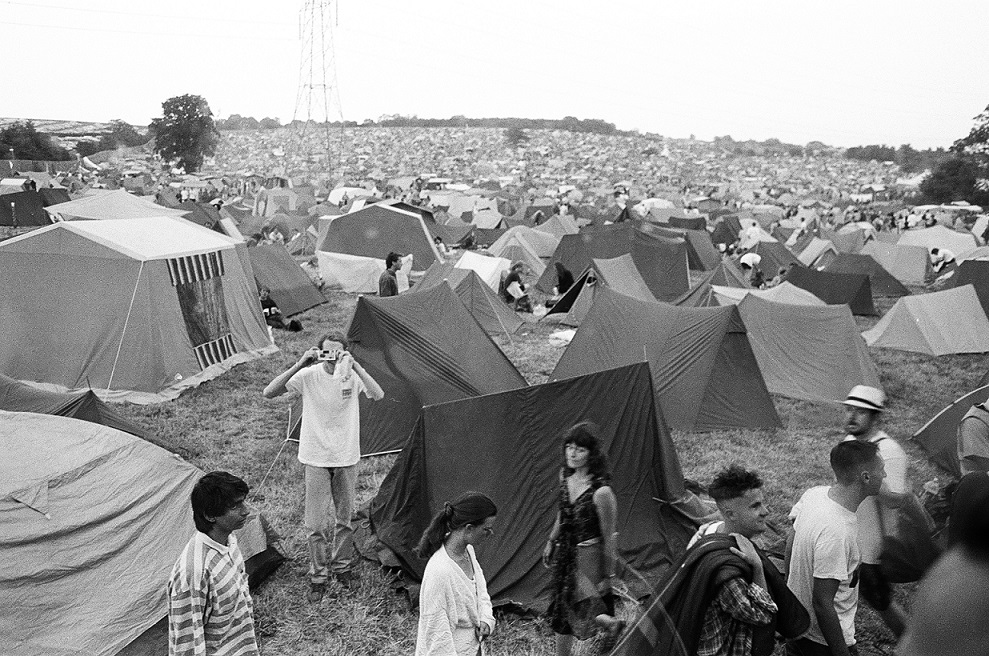 Linda Lee Welch, 43, performer, Theatre Ground and Around: Everybody’s got a scar or two and they all like showing them off. We wore costumes and bright hats, and there was an award ceremony after each story. The participants were given a prize. I think it was a chocolate, accompanied by a kazoo fanfare.
Linda Lee Welch, 43, performer, Theatre Ground and Around: Everybody’s got a scar or two and they all like showing them off. We wore costumes and bright hats, and there was an award ceremony after each story. The participants were given a prize. I think it was a chocolate, accompanied by a kazoo fanfare.
Jiří Sandoz, 21, festival-goer: I hitchhiked from Castle Cary on Saturday, then realised I've got to get in. I just walked around the whole site, around the wall, until this dodgy geezer, tall, skinny black guy who had an 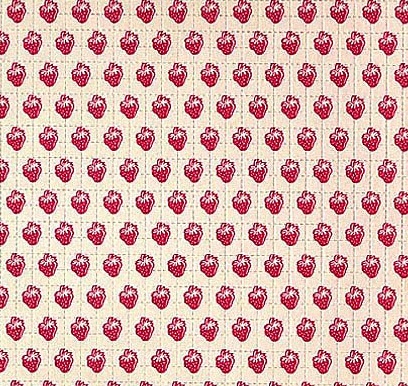 American accent came up and said, “Do you want a wrist band? Five quid?” When we were about 100 metres into the site, I gave him the wristband back. “Cheers, mate,” he said, “Have a good Glastonbury.” Now I had this weird situation where I’m there partly to confront this girl and find out if we’re still together. No mobile phones then so I basically did a spiral from the sides of the site all the way into the middle, until I saw a sign up on a hill that just said “Brum”. I found my mates’ tents, but nobody was there, so I decided to take a strawberry acid tab and just see what happened.
American accent came up and said, “Do you want a wrist band? Five quid?” When we were about 100 metres into the site, I gave him the wristband back. “Cheers, mate,” he said, “Have a good Glastonbury.” Now I had this weird situation where I’m there partly to confront this girl and find out if we’re still together. No mobile phones then so I basically did a spiral from the sides of the site all the way into the middle, until I saw a sign up on a hill that just said “Brum”. I found my mates’ tents, but nobody was there, so I decided to take a strawberry acid tab and just see what happened.
Martha D Lewis, 29, Donna & Kebab (Outside Theatre and other stages, all three days): It was boiling hot, unexpectedly, just a scorcher. Everybody was scrambling to buy sun cream but there was none to be found, because nobody anticipated the heatwave. It had an impact on energy levels. We were doing more than one appearance a day, and we had to keep on top of it. We were struggling after day two.
Eve Polycarpou, 37, Donna & Kebab (Outside Theatre and other stages, all three days): The thing is that when you’re performing, you're supposed to be looking OK, your clothes, your guitars, but doing that while being a punter at Glastonbury is absolutely impossible. Plus, you know, we were stoned quite a lot of time; most performers were because it was just passing around.
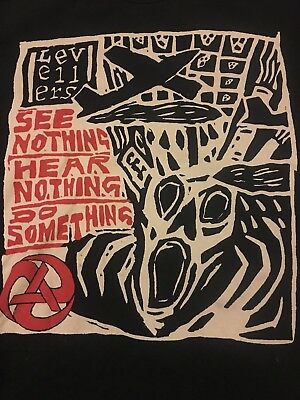 Kevin Geraghty-Shewan, 30, festival-goer: The Levellers were on late afternoon at the Pyramid. Such was their popularity that everyone wondered why they weren't headlining. We put Bethany in the backpack and headed off to see them. The band was on top form but blotted their copybook with the festival organisers by criticising them for the decision not to let the travellers onto the site (although Michael Eavis sought the band out afterwards and explained his reasons, and they kissed and made up). Bethany sat in the backpack throughout the set until they band played “One Way”, at which point she recognised the song and danced away in the best seat in the house.
Kevin Geraghty-Shewan, 30, festival-goer: The Levellers were on late afternoon at the Pyramid. Such was their popularity that everyone wondered why they weren't headlining. We put Bethany in the backpack and headed off to see them. The band was on top form but blotted their copybook with the festival organisers by criticising them for the decision not to let the travellers onto the site (although Michael Eavis sought the band out afterwards and explained his reasons, and they kissed and made up). Bethany sat in the backpack throughout the set until they band played “One Way”, at which point she recognised the song and danced away in the best seat in the house.
Ben Graham, 21, litter-picker: The Levellers was a frightening moment. The field was packed with their fans, like they were the most popular band ever, millions of sixth form girls in One Way of Life T-shirts. They were alright, but I was alienated by the huge fanatical audience.
Russell Hiscox, 16, Festival-goer: The House of Love appeared on the Pyramid with balloons all over the stage. At the end of the set the drummer threw a drumstick that he had broken earlier into the crowd. It seemed to fly into my hand and I went off very happy. I was fortunate because there were stories about Nirvana throwing a smashed guitar at the Reading Festival later in the year. The story went that the person who picked up the guitar got their tent raided in the night and beaten up and the guitar stolen.
Joe Muggs, 18, festival-goer: Mr C played a pure 303 DJ set before The Shamen came on.
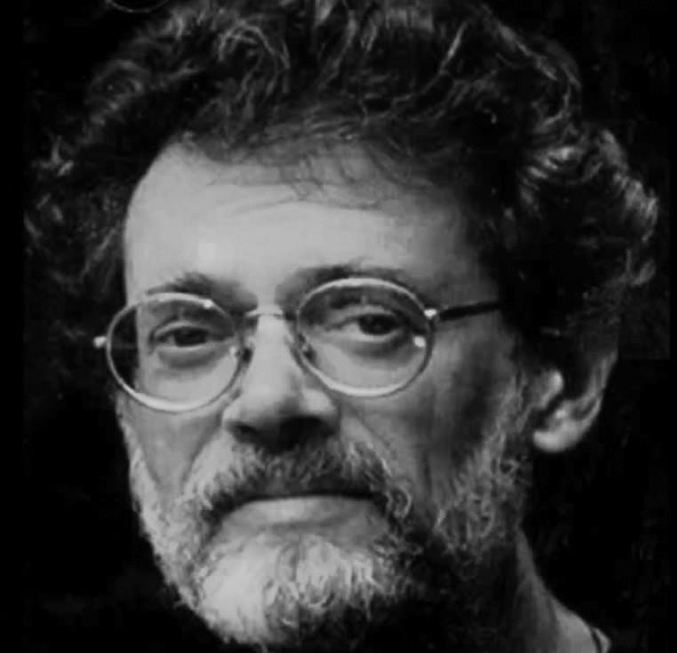 Guarin Tees, 20, festival-goer: My first Glastonbury. Saturday afternoon NME stage was a thing of legend; Ozric Tentacles in the acid-drenched sun; Curve's Toni Halliday entering on a white swan. Wind-affected sound only enhancing the chemically induced weirdness, and then The Shamen. What a show that was, red and green lasers firing over the crowd, sweat-steam rising through the laser-canopy, appearing like trillions of tiny rainbow bubbles, the sky turned liquid, Terence McKenna's voice visually represented by a single yellow laser, describing his voice as patterns in the sky. At the end, an announcement; “The bridge is broken.” Turned out the announcer wasn’t referring to the bridge between the stage and our joint pysche, but an actual bridge over a ditch, leaving the field. We were then off to see the wicker man to be burnt as a midsummer offering. We never made it, but did all manage to get to our tents without tripping on one single guy-rope.
Guarin Tees, 20, festival-goer: My first Glastonbury. Saturday afternoon NME stage was a thing of legend; Ozric Tentacles in the acid-drenched sun; Curve's Toni Halliday entering on a white swan. Wind-affected sound only enhancing the chemically induced weirdness, and then The Shamen. What a show that was, red and green lasers firing over the crowd, sweat-steam rising through the laser-canopy, appearing like trillions of tiny rainbow bubbles, the sky turned liquid, Terence McKenna's voice visually represented by a single yellow laser, describing his voice as patterns in the sky. At the end, an announcement; “The bridge is broken.” Turned out the announcer wasn’t referring to the bridge between the stage and our joint pysche, but an actual bridge over a ditch, leaving the field. We were then off to see the wicker man to be burnt as a midsummer offering. We never made it, but did all manage to get to our tents without tripping on one single guy-rope.
Angela B, 18, festival-goer: Our tent was stolen and we ended up bunking up with some other friends who were pitched at the top of the Pyramid field. I learnt a big lesson from the tent being stolen, which is don’t take tins of food to Glastonbury, there’s plenty of food there and even if the tins aren’t stolen with your tent, you won’t eat them, and they’re really heavy.
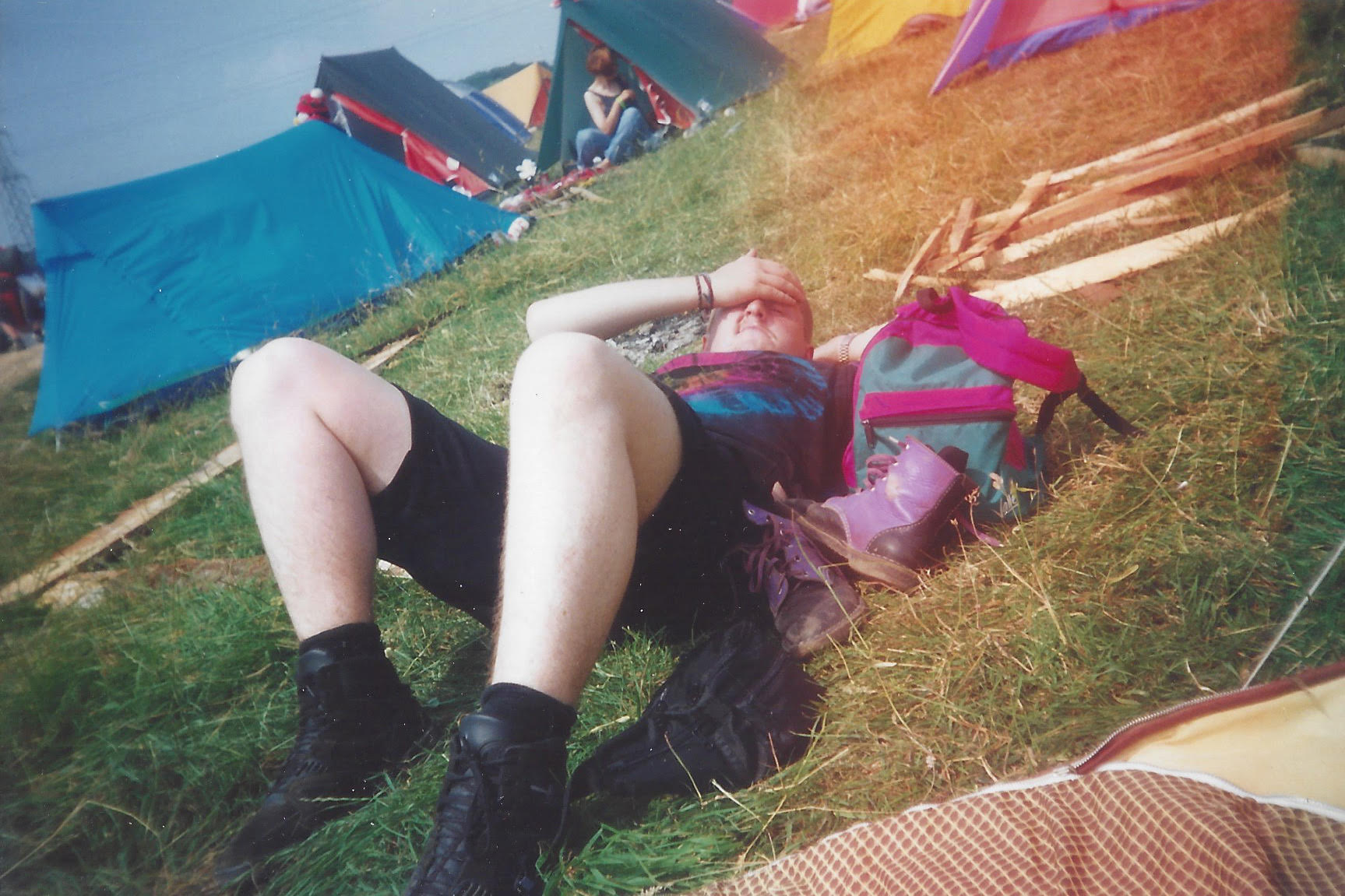 Russell Hiscox, 16, Festival-goer: The Fall had to put up with people shouting “Hit the North” between each song. Then I remember my disappointment when I went to the Pyramid Stage to see Morrissey. He had pulled out at the last minute, claiming he had never committed in the first place, and James appeared instead. James opened with the Morrisey song “We Hate It When Our Friends Become Successful”. I saw a Smiths fan run from the camping area because he thought that it was Moz himself.
Russell Hiscox, 16, Festival-goer: The Fall had to put up with people shouting “Hit the North” between each song. Then I remember my disappointment when I went to the Pyramid Stage to see Morrissey. He had pulled out at the last minute, claiming he had never committed in the first place, and James appeared instead. James opened with the Morrisey song “We Hate It When Our Friends Become Successful”. I saw a Smiths fan run from the camping area because he thought that it was Moz himself.
Ben Graham, 21, litter-picker: Lou Reed was wearing a horrible anorak. As we arrived there were fires all up the hillside, an ambulance pushing its way through the crowd, and Lou was just launching into “Rock n’ Roll”. I started getting that Altamont feeling but Lou was good, even the new stuff, and he encored with “Vicious” before murdering “Satellite of Love”, which was even worse than U2’s version.
Pat Corley, 39, festival-goer and book-seller: One act that really stands out in my memory was the late, great Lou Reed. Me, Dave, Kim and others went for a huge walk all over the site and when we reached the Pyramid Stage Lou was on. He performed a great set including “Sweet Jane”, “Walk On The Wild Side”, “Rock & Roll” and, finally, “Vicious”. We knew he would be back for an encore so me and Dave had a little wager on what song he would sing. I won with “Satellite Of Love” and Dave actually paid up!
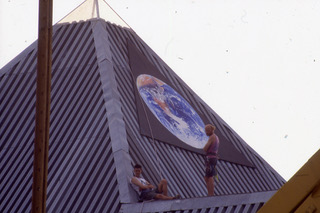 Mark Cann, 41, head of Pyramid production: When Lou Reed came, he’d been staying with Peter Gabriel, who bought him down to the festival. By the time he wanted to leave, all his crew had gone, so a friend of mine, Steph, was deputed to drive him to Castle Cary train station. “I can take trains,” he said, so Steph had the excitement, outside the normal bubble that surrounds such people, of chauffeuring her hero and putting him on a train to London packed with festival-goers.
Mark Cann, 41, head of Pyramid production: When Lou Reed came, he’d been staying with Peter Gabriel, who bought him down to the festival. By the time he wanted to leave, all his crew had gone, so a friend of mine, Steph, was deputed to drive him to Castle Cary train station. “I can take trains,” he said, so Steph had the excitement, outside the normal bubble that surrounds such people, of chauffeuring her hero and putting him on a train to London packed with festival-goers.
Tony Cordy, 35, Green Lights Oasis director: I'm almost certain I put on Nik Turner, and there was a band called Car Mechanics who were some of Here & Now, and a black band called Ambush. We had a good range of mad circus acts and bizarre theatrics, then in one corner of the field we had a bunch of people called Offshore Circus doing projections on this massive screen.
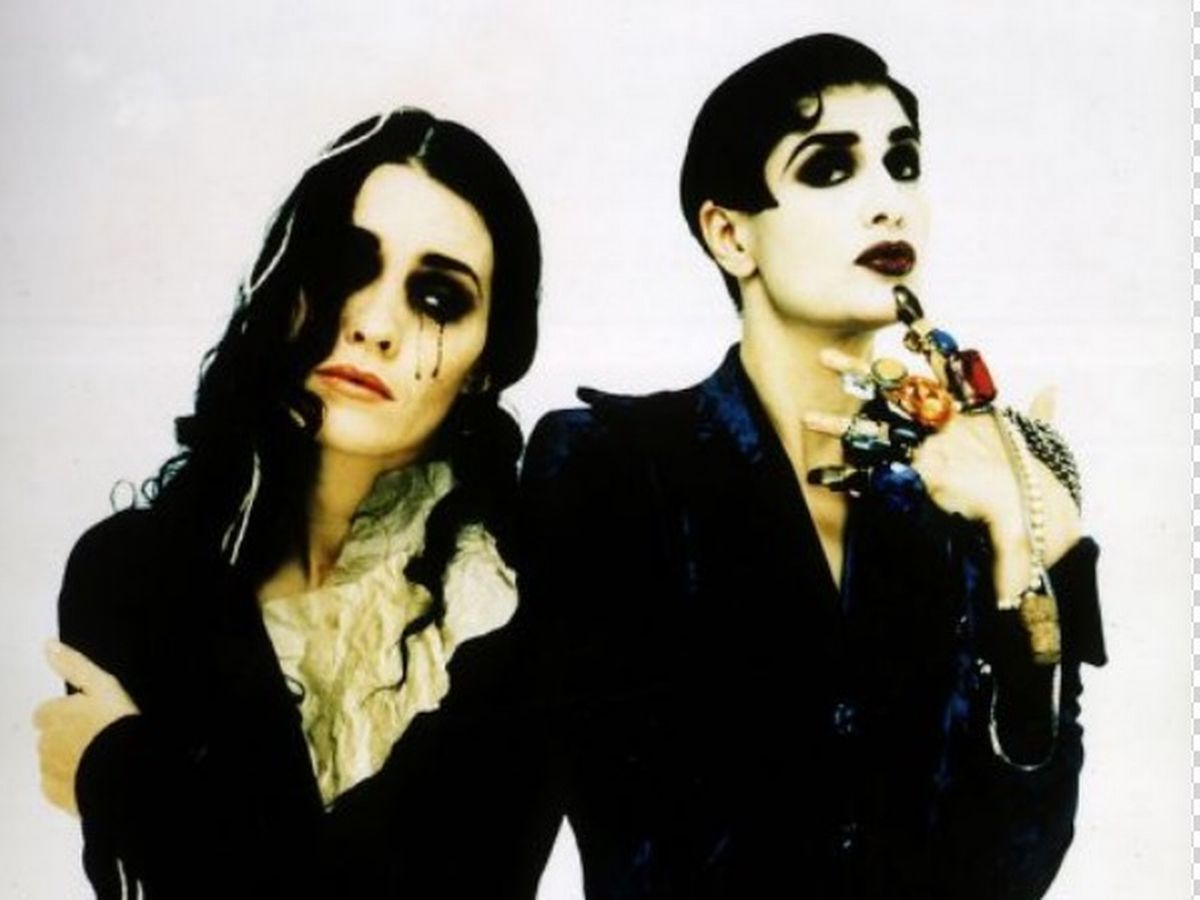 Siobhan Fahy, 33, Shakespears Sister (11.30 PM, Pyramid) (pictured right): We turned up on Friday and stayed at a nearby hotel. We were on the Pyramid and Lou Reed was immediately before us, which was kind of mind-blowing. It did make me pause for thought, going on after Lou Reed. I wondered why he was on before us and thought maybe he wanted to go to bed early. I remember the shite conditions backstage, a Portakabin literally like a shed, with a table and one chair, no hospitality, really appalling, and that cabin wasn’t even available until an hour before we went on stage. But whenever people ask about the standout achievements of my career, obviously that’s one of them. It was kind of mind-blowing to do it, this vast spectacle, you look out and in front of you it raises up at the back, pitch black out there, just the rim of the hill in the distance, all these bonfires, the scale of it was primal and enormous. I’m still not used to playing such large places, but we left the festival early instead of hanging out for weekend, as we had to fly to another festival in Sweden.
Siobhan Fahy, 33, Shakespears Sister (11.30 PM, Pyramid) (pictured right): We turned up on Friday and stayed at a nearby hotel. We were on the Pyramid and Lou Reed was immediately before us, which was kind of mind-blowing. It did make me pause for thought, going on after Lou Reed. I wondered why he was on before us and thought maybe he wanted to go to bed early. I remember the shite conditions backstage, a Portakabin literally like a shed, with a table and one chair, no hospitality, really appalling, and that cabin wasn’t even available until an hour before we went on stage. But whenever people ask about the standout achievements of my career, obviously that’s one of them. It was kind of mind-blowing to do it, this vast spectacle, you look out and in front of you it raises up at the back, pitch black out there, just the rim of the hill in the distance, all these bonfires, the scale of it was primal and enormous. I’m still not used to playing such large places, but we left the festival early instead of hanging out for weekend, as we had to fly to another festival in Sweden.
Ben Graham, 21, litter-picker: We were pretty close to the front for Shakespear’s Sister. Great fun, big shiny pop in sparkly suits and a totally glam-rocking guitarist, lots of jumping around and silliness. They encored with T. Rex’s “Hot Love”. Yeah! Best band so far.
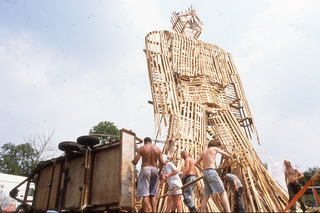 Arabella Churchill, 42, Theatre and Circus Fields organizer: We were all ready to burn the wicker man on Saturday night and word had really got out about this show, so there was a lot of expectation. But then there’s a bit of a wind, Haggis [McLeod, her husband] thought it’s a bit strong and we asked the fireman and they said, “Go! Go!” But then the first fireworks go off and they start landing on top of the cabaret tent. The guy who runs it, Mike Hearst, was in tears, and Haggis said, “You’ve got to stop!”, and I say, “The firemen said it’s fine.” And Haggis phones Michael [Eavis] and he said we had to stop. By now we have an enormous crowd all wanting to burn the wicker man. So I get a microphone and say, “Sorry, the wind is all wrong, we’re not going to do it tonight, please come back tomorrow.” But nobody goes away and they stand there shouting, “Burn it! Burn it!” and even “Burn the farmhouse!” and “Burn Bella!”. So I had to remain by the wicker man all night, patrolling it, otherwise somebody was going to set it off, for certain.
Arabella Churchill, 42, Theatre and Circus Fields organizer: We were all ready to burn the wicker man on Saturday night and word had really got out about this show, so there was a lot of expectation. But then there’s a bit of a wind, Haggis [McLeod, her husband] thought it’s a bit strong and we asked the fireman and they said, “Go! Go!” But then the first fireworks go off and they start landing on top of the cabaret tent. The guy who runs it, Mike Hearst, was in tears, and Haggis said, “You’ve got to stop!”, and I say, “The firemen said it’s fine.” And Haggis phones Michael [Eavis] and he said we had to stop. By now we have an enormous crowd all wanting to burn the wicker man. So I get a microphone and say, “Sorry, the wind is all wrong, we’re not going to do it tonight, please come back tomorrow.” But nobody goes away and they stand there shouting, “Burn it! Burn it!” and even “Burn the farmhouse!” and “Burn Bella!”. So I had to remain by the wicker man all night, patrolling it, otherwise somebody was going to set it off, for certain.
Joe Muggs, 18, festival-goer: A really jittery, cagey Welsh crusty tried to sell us some whizz at an implausibly low price, so we asked to have a taste, and there was hilarity when we all screwed our faces up simultaneously because it was citric acid. We also got ripped off for some “red microdots” which turned out to be Nutrasweet painted with nail varnish.
Liz Eliot, 51, Green Fields co-ordinator: We had lots of drug dealers in dark corners. It was very dark in those days, not a lot of lighting as there is now, but it was edgy and lovely.
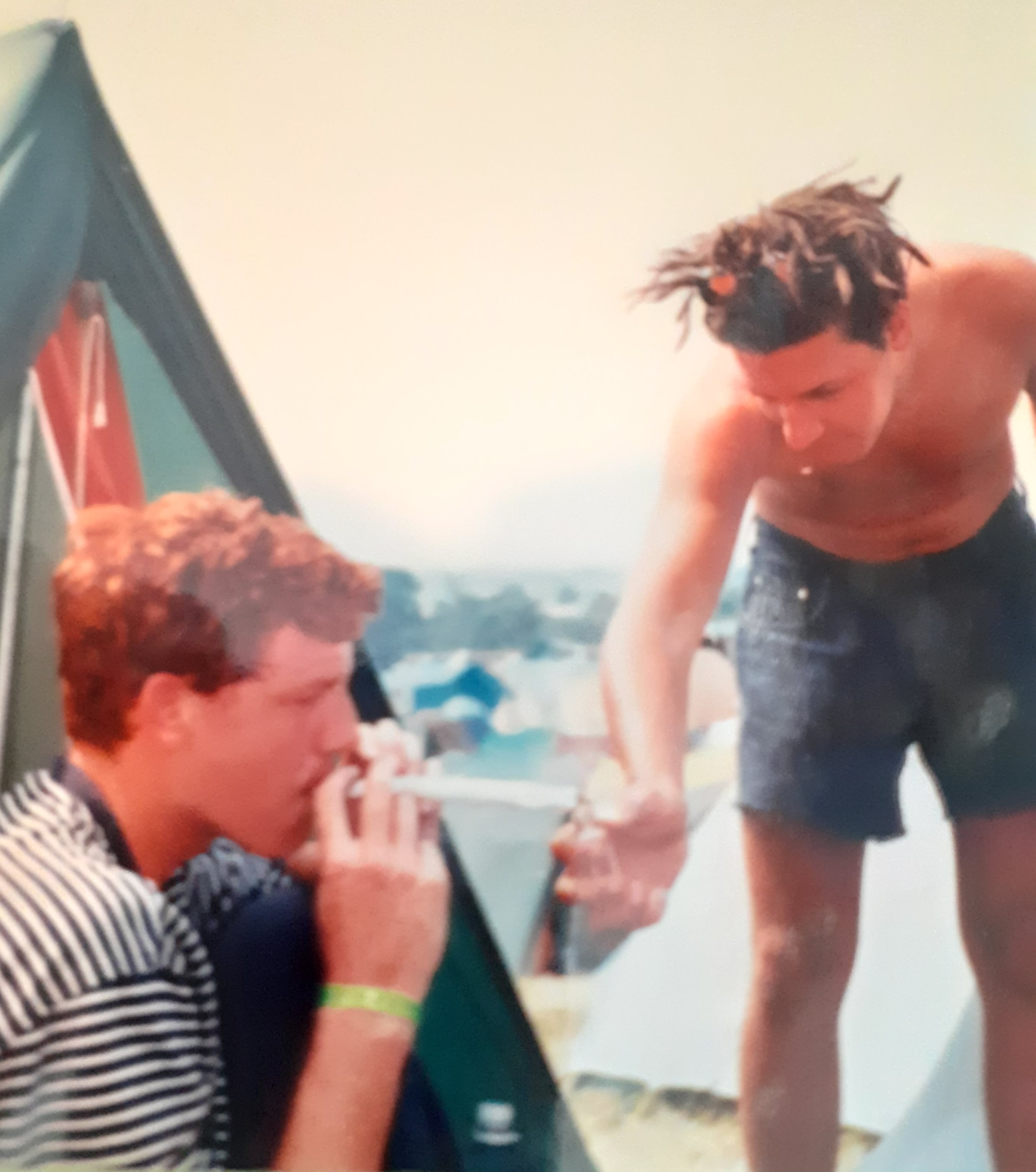 Graham Sugarlump, 32, Sugarlump Sound System: When you went over Yeoman’s Bridge, there was a long bush that led to the NME field. We basically had that corner, right in the centre of Glastonbury, a big illegal 16k turbo sound system. The loophole was that arts and entertainment had to close at 11 o'clock but if you went as a market trader, you could trade for 24 hours. We didn't sell anything, never tried to, just put on an illegal event.
Graham Sugarlump, 32, Sugarlump Sound System: When you went over Yeoman’s Bridge, there was a long bush that led to the NME field. We basically had that corner, right in the centre of Glastonbury, a big illegal 16k turbo sound system. The loophole was that arts and entertainment had to close at 11 o'clock but if you went as a market trader, you could trade for 24 hours. We didn't sell anything, never tried to, just put on an illegal event.
Jesse D Vernon, 22, Moonflowers (2.00 PM, NME Stage): I don’t remember much about Glastonbury 1992 except for an amazing early hours jam session in a backstage tent somewhere – was it Fungus Mungus? - with Jerry Dammers [of The Specials], an impromptu horn section, and a fantastic drummer; very inspirational - mind blowing, in fact.
Caspar Gomez, 24, festival-goer: It’s weird to think we used to go and see films at Glastonbury but we did. The ubiquitous availability of all cinema was not as it is now and it was a treat to catch offbeat and cult films in a smoke-laden haze when your legs decided enough was enough. In these circumstances, after a hectic three days dancing, the then-new-ish surreal French post-apocalyptic cannibalism comedy Delicatessen at 2.00 AM in the cinema marquee was as delicious as it was bizarre.
Russell Hiscox, 16, festival-goer: After the stages were empty and the bands had finished, I would go to a tent that had a DJ playing out of a truck cab that was actually in the tent. This was called Sugarlump and, even though I was not really into the music, the atmosphere was amazing. On one night the generator that was powering everything kept on breaking down. As soon as the lights and music cut out hundreds of whistles blew and it seemed that everyone was wearing a glow necklace.
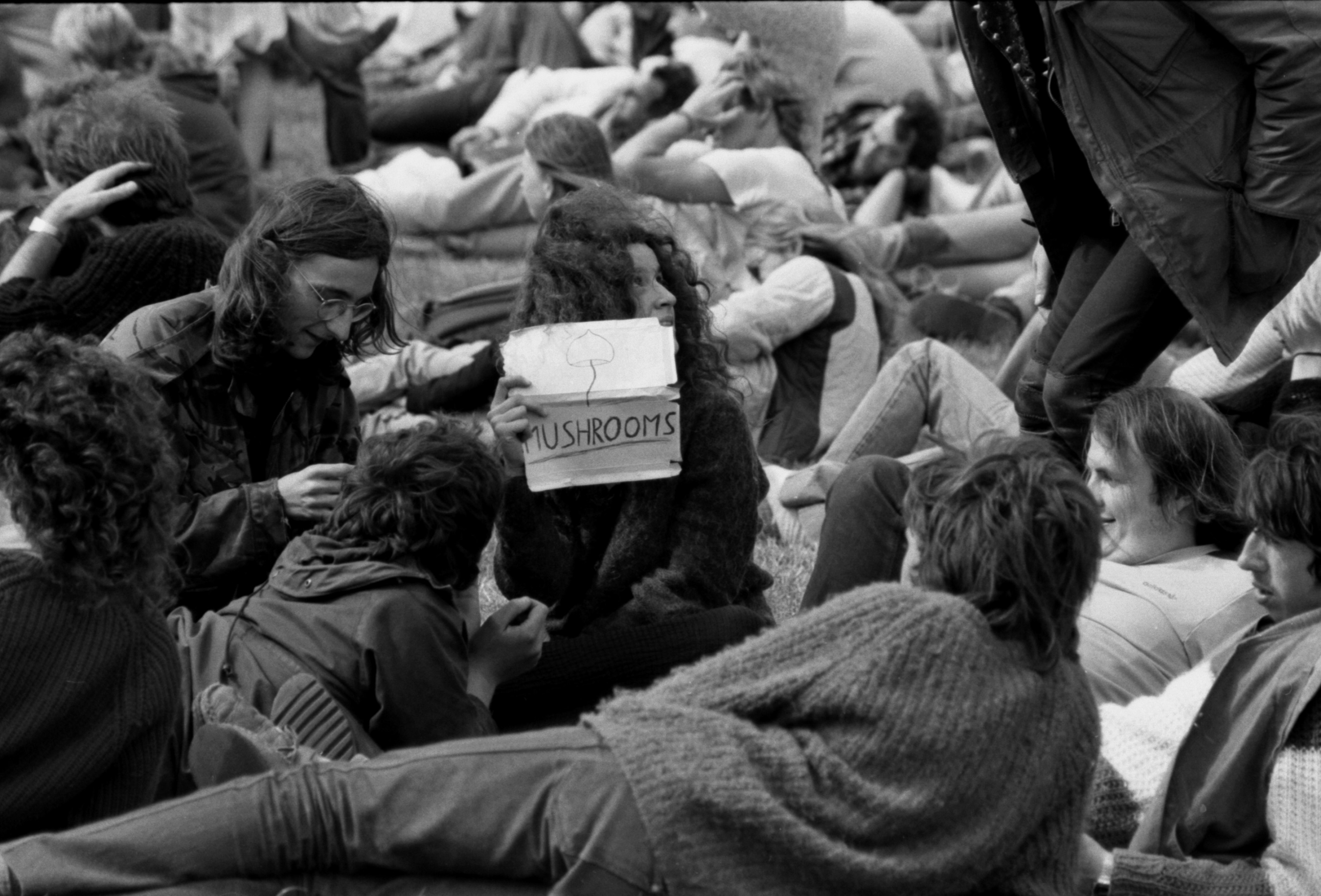 Jiří Sandoz, 21, festival-goer: I had a very nice time wandering around spangled, slowly bumping into people I knew. Eventually they said, “Yeah, we're all meeting back at the tents at seven o'clock.” And my girlfriend would be there. But they were kind of pulling these funny faces like, “Oh, we didn't expect you to be here.” So I went and met her, and there was a weird moment where I realised she was there with this other guy, with all my mates knowing it. We were all high in various different ways, so I kind of laughed it off, but, also, it wasn't totally out in the open. It was a little bit like, “Am I going mad? Is this really happening?” So we spent the whole night exploring, tripping, even at one point just me, her and this new guy walking through the Green Fields. It was all like an illusion. Then morning crept in and everybody went back to the tents, people were crashing out. I was too, and I realised my girlfriend and this guy were cuddling up in the tent, then the tent zip went down. From that point on, I was coming down. Reality was there. It was fucking tragic, a disaster. I fell asleep in the communal bit between the tents in the boiling morning sun.
Jiří Sandoz, 21, festival-goer: I had a very nice time wandering around spangled, slowly bumping into people I knew. Eventually they said, “Yeah, we're all meeting back at the tents at seven o'clock.” And my girlfriend would be there. But they were kind of pulling these funny faces like, “Oh, we didn't expect you to be here.” So I went and met her, and there was a weird moment where I realised she was there with this other guy, with all my mates knowing it. We were all high in various different ways, so I kind of laughed it off, but, also, it wasn't totally out in the open. It was a little bit like, “Am I going mad? Is this really happening?” So we spent the whole night exploring, tripping, even at one point just me, her and this new guy walking through the Green Fields. It was all like an illusion. Then morning crept in and everybody went back to the tents, people were crashing out. I was too, and I realised my girlfriend and this guy were cuddling up in the tent, then the tent zip went down. From that point on, I was coming down. Reality was there. It was fucking tragic, a disaster. I fell asleep in the communal bit between the tents in the boiling morning sun.
SUNDAY 28th JUNE
Rowan Chapman, 18, festival-goer: When Glastonbury is hot, it’s really hot with little or no shelter anywhere. Being naive and disorganised, none of us had sun cream and slowly, as the weekend went on, we all got fried… quite literally.
Joe Muggs, 18, festival-goer: I danced like heck to Spiritualized of all people.
Russell Hiscox, 16, festival-goer: Blur appeared on the NME Stage all dressed in suits. Damon climbed the lighting rig and then jumped on a speaker stack that toppled over. He broke his foot doing this, but at the time he carried on and I was unaware he had injured himself.
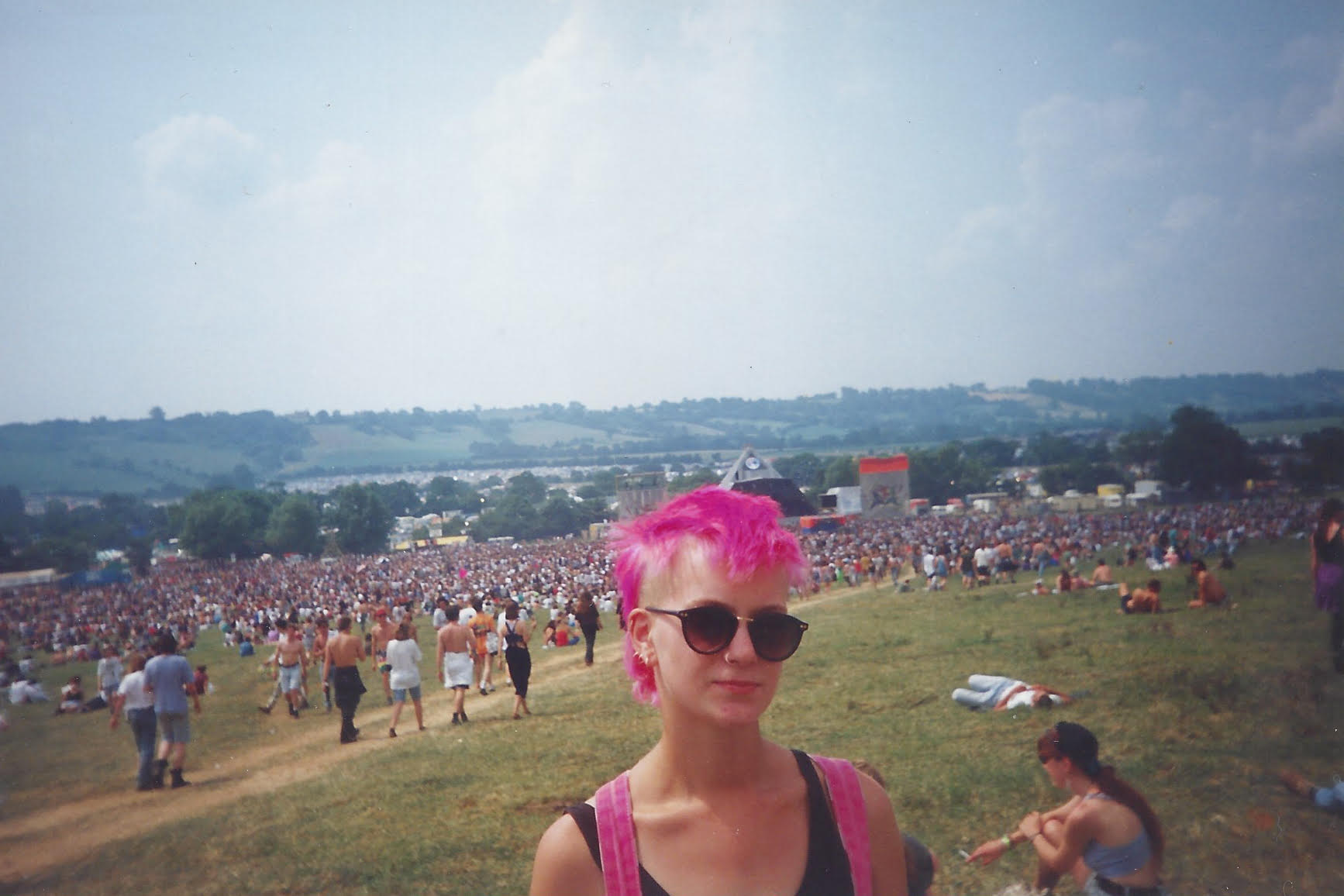 Pat Corley, 39, festival-goer and book-seller: By Sunday afternoon there is always a chilled-out atmosphere at Glasto which is just perfect for Van Morrison. Kim and I got right to the front. It was so hot that the security on the other side of the barrier were spraying the crowd with water to cool them down and handing out cups of water. A lot of these got thrown up in the air which was quite amusing.
Pat Corley, 39, festival-goer and book-seller: By Sunday afternoon there is always a chilled-out atmosphere at Glasto which is just perfect for Van Morrison. Kim and I got right to the front. It was so hot that the security on the other side of the barrier were spraying the crowd with water to cool them down and handing out cups of water. A lot of these got thrown up in the air which was quite amusing.
Caspar Gomez, 24, festival-goer: I spent much of the day smoking doobies, lounging on the rough, sack-like coir herringbone matting in the Cabaret Tent, watching the likes of Mark Thomas, and Simon Day’s music hall character, Tommy Cockles. Especially on Sunday, it was awash with horizontal bodies, chaining through king-skins or snoozing. It wasn’t a tough crowd, though. Spaced out, for sure, but provided the comedians could handle feral children, and chucked in enough druggy jokes and surreal silliness, all was well.
Kevin Geraghty-Shewan, 30, festival-goer: Sunday afternoon had a space in the Pyramid schedule which was designated “Special Guest”. In the past this had meant that at the time of going to press they still hadn’t booked anyone. After seeing Richard Thompson around lunchtime, we went to the Information Tent to find out who was on. The sign said Tom Jones. The only Tom Jones I could think of was “My, my, my, Delilah” Tom Jones. It couldn't be that one, could it? Yes it was! When the time came, we wandered down to the Pyramid stage and, sure enough, there was the gravel-voiced Welshman working his way through his back catalogue. He was fantastic, and so the Sunday afternoon “Old Duffers” spot was born.
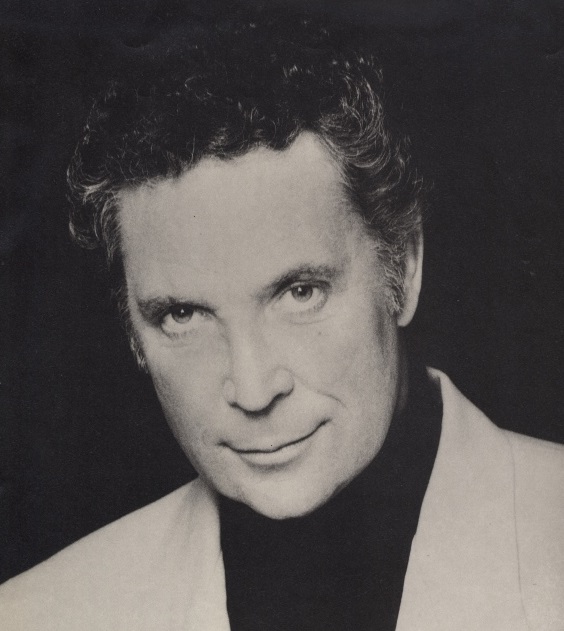 Mark Cann, 41, head of Pyramid production: When Tom Jones appeared, his band turned up and looked very, very nervous because this was outside their normal experience – they just wouldn’t normally appear in the middle of a field in Somerset. It was almost like they took a deep breath when they got off the bus. But they soon relaxed into it. Most people do have a good time; some have an exceptionally good time and go AWOL. There’s always been the occasional star who disappears and the tour manager is tearing their hair out trying to track them down.
Mark Cann, 41, head of Pyramid production: When Tom Jones appeared, his band turned up and looked very, very nervous because this was outside their normal experience – they just wouldn’t normally appear in the middle of a field in Somerset. It was almost like they took a deep breath when they got off the bus. But they soon relaxed into it. Most people do have a good time; some have an exceptionally good time and go AWOL. There’s always been the occasional star who disappears and the tour manager is tearing their hair out trying to track them down.
Ben Graham, 21, litter-picker: We got ourselves right down the front for Tom Jones, who was undoubtedly the highlight of the festival. He seemed somewhat bemused but gave his all on such as Prince’s “Kiss” – twice – and “Purple Rain”, EMF’s “Unbelievable”, as well as “Too Hot To Handle”, “Come Together”, “It’s Not Unusual”, and a load of soul/R&B classics. It was being filmed by HTV and everyone was having a great time; dreadlocked travellers on each other’s shoulders. We left elated, feeling that Ned’s Atomic Dustbin and 808 State would be an anticlimax after that, so went back to our tent, had sex, and slept till midnight, when we were awoken by drumming and fireworks. We went over to the Fire Field in time to see the giant wicker man being burnt. Then we went out wandering, ate some cake and ended up at the Outside Cinema watching The Fisher King till 3 AM.
Arabella Churchill, 42, Theatre and Circus Fields organizer: Big fire shows are always exciting. The wicker man performers were an amazing group - there were 50 or 60 of them – dancers, high tightrope walkers, people inside huge plastic balls, and this giant person made of wood, sixty foot high. We’d had phone messages saying, “The wicker man is a pagan symbol and if it’s burned I’m going to incinerate myself in it.” So I’m up with some friends next to the pigtail security barrier ready to rugby tackle anyone who run towards it. We even searched it before burning to make sure nobody was hidden inside. I was determined [the debacle of Saturday night wasn’t going to happen again]. But when we did set it off, we had the whole performance and it was fantastic. Word had really got round and this was then biggest audience we’d ever had.
 Kevin Geraghty-Shewan, 30, festival-goer: Later in the evening we headed over to the Avalon Stage to see ex-Gong frontman Daevid Allen. The Avalon Stage was in a small tent up in the Green Field and at that time was in its infancy. When we arrived, we thought it was Gong on the stage as we could hear what we thought was a Gilli Smyth sound-alike singing. It turned out to actually to be Gilli Smyth playing with a band called Kangaroo Moon. They overran a lot, and in the end, we left before Daevid Allen came on.
Kevin Geraghty-Shewan, 30, festival-goer: Later in the evening we headed over to the Avalon Stage to see ex-Gong frontman Daevid Allen. The Avalon Stage was in a small tent up in the Green Field and at that time was in its infancy. When we arrived, we thought it was Gong on the stage as we could hear what we thought was a Gilli Smyth sound-alike singing. It turned out to actually to be Gilli Smyth playing with a band called Kangaroo Moon. They overran a lot, and in the end, we left before Daevid Allen came on.
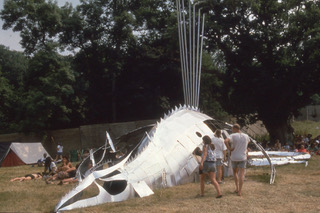 Liz Eliot, 51, Green Fields co-ordinator: The Stone Circle was in a sacred field in ’92, centred around earth, fire, air and water. The stones were the earth and there was a fire dragon (pictured left) made by [sculptor] Ray Brooks. On Sunday night they set fire to it in a way that was absolutely brilliant because, first of all, it spouted all these flames out of its mouth, down the hill, and, and then it caught fire and burned and there was an egg inside it.
Liz Eliot, 51, Green Fields co-ordinator: The Stone Circle was in a sacred field in ’92, centred around earth, fire, air and water. The stones were the earth and there was a fire dragon (pictured left) made by [sculptor] Ray Brooks. On Sunday night they set fire to it in a way that was absolutely brilliant because, first of all, it spouted all these flames out of its mouth, down the hill, and, and then it caught fire and burned and there was an egg inside it.
 Caspar Gomez, 24, festival-goer: 1992 was the last time I recall there being actual stalls with cardboard signs advertising various drugs. The signage appeared after sundown, by which time I was flying on a combination of Ecstasy and LSD. Either despite or because of this, I couldn’t resist a marquee at the back of the NME Stage field with just such temptations listed on a large menu card by the entrance. Inside, a guy was selling hot knives by a gas stove (blims of hash pressed between two red hot knives, the resultant smoke sucked up via a broken-ended glass bottle). A whole range of illicit drugs were available, from magic mushrooms to cocaine. Shadowy figures milled about purchasing their final boost to rocket through to the festival’s end. There was a closing down sale vibe that added carnival atmosphere, also fuelled by raw jollity at blatant illegality so openly flaunted. I bought a small baggy of greasy speed and gulped a large, crumbly, wet finger-full down. It hit fast and clean, re-energizing the drugs already in my system, roller-coastering me upwards fast.
Caspar Gomez, 24, festival-goer: 1992 was the last time I recall there being actual stalls with cardboard signs advertising various drugs. The signage appeared after sundown, by which time I was flying on a combination of Ecstasy and LSD. Either despite or because of this, I couldn’t resist a marquee at the back of the NME Stage field with just such temptations listed on a large menu card by the entrance. Inside, a guy was selling hot knives by a gas stove (blims of hash pressed between two red hot knives, the resultant smoke sucked up via a broken-ended glass bottle). A whole range of illicit drugs were available, from magic mushrooms to cocaine. Shadowy figures milled about purchasing their final boost to rocket through to the festival’s end. There was a closing down sale vibe that added carnival atmosphere, also fuelled by raw jollity at blatant illegality so openly flaunted. I bought a small baggy of greasy speed and gulped a large, crumbly, wet finger-full down. It hit fast and clean, re-energizing the drugs already in my system, roller-coastering me upwards fast.
Stefan Linne, 31, Sheinbar Varieté (Circus Big Top all three days): There was lots of techno everywhere. This was brand new but I didn't like it too much. Then one night, we found a tent of the Hari Krishna people, and this was very, very lovely. This was a kind of, I don’t know, analogue techno, always the same rhythm, Hari, Hari, Hari. All the nice girls in orange, so cool. It was very, very nice. I love Glastonbury.
Caspar Gomez, 24, festival-goer: Back amidst the NME Field crowd, flying after my dose-up, a behatted dred MC was onstage shouting, “Are you ready?” over Doctor Who-ish synth noises. 808 were onstage between two giant neon 8s. Then the descending minor key stabs of “Cubik”. It sounded then like rave Armageddon, sending rushes and tingles to my core. Lasers followed. “Do you really know the score, hardcore?” A bowl-headed dude onstage waved a fan about and freaky danced. “Calling out free spirits, calling out the expressionists”. Finally, “Pacific State” and fireworks, although they might just have been in my brain. It remains one of my all-time wired and most glorious highs.
Below: Shonky but atmospheric handheld footage of most of 808 State's set at Glastonbury Festival 1992
Graham Sugarlump, 32, Sugarlump Sound System: Only four or five of us DJed, then we just invited friends down. On the decks we had Nick the Record, Darius Akashic, DJ Chakra, friends from Nottingham’s DIY [sound system], Caz Peake, Sister T, all on rotation. There was one point when there was maybe four or five thousand people in front of the speakers as far as the eye could see, just blowing whistles and horns. One night there was a group of Rastas from Manchester lined up along the fence from Yeoman's Bridge. They’d cut a path through the bush and charged people a tenner to go to a rave on the other side of it. It was Sugarlump and all you had to do was walk on through the gate and you were in there for free, but they made a fortune.
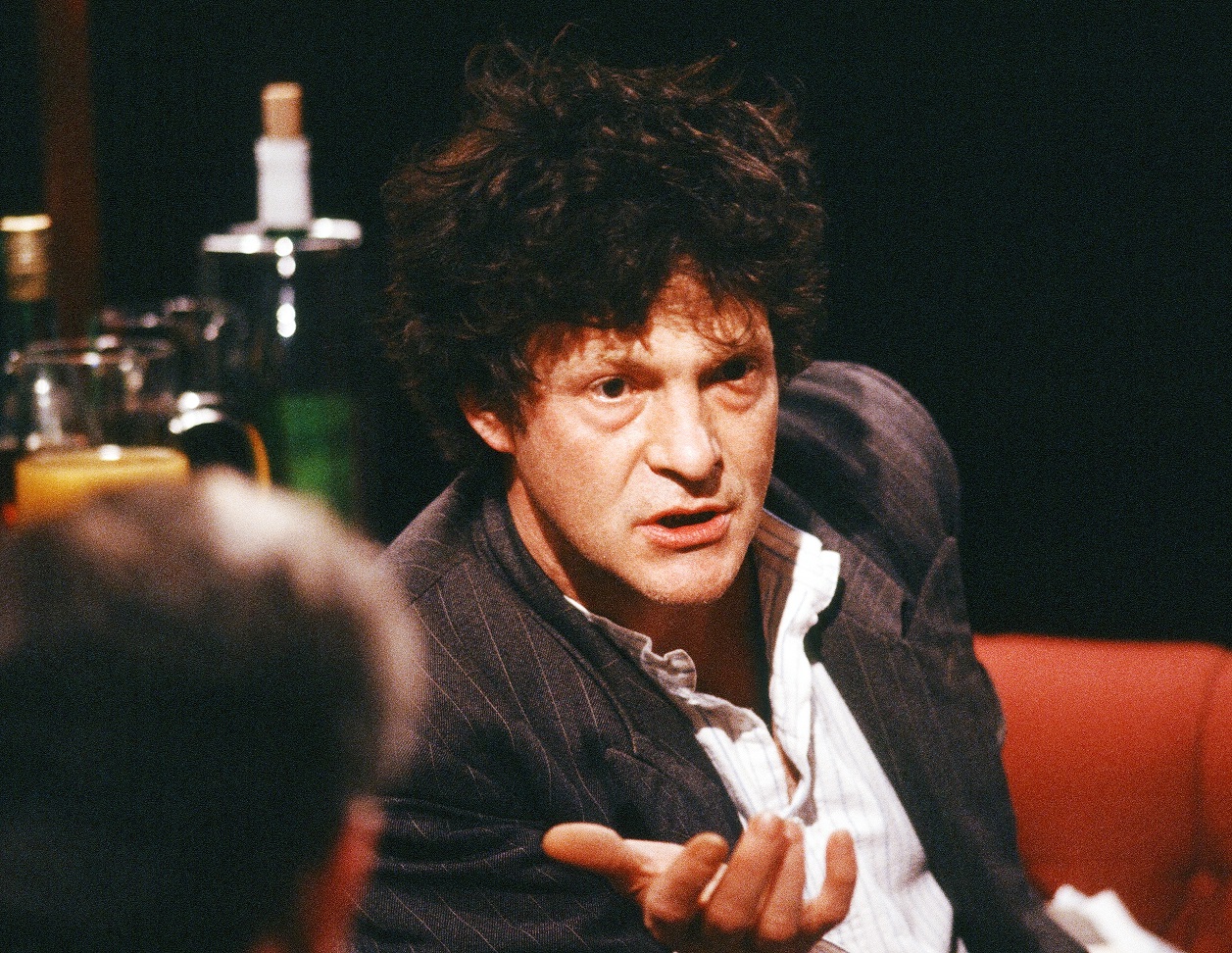 Tony Cordy, 35, Green Lights Oasis director: I put on my mate [the poet] Heathcote Williams (pictures right). That was hilarious. He came on about half past midnight, and he was basically naked, and had wrapped himself in clingfilm. The audience really didn’t know what to make of it. It was one of his best acts ever but some of the audience were booing and hissing and the rest were, like, “Wow, what’s this, man?”
Tony Cordy, 35, Green Lights Oasis director: I put on my mate [the poet] Heathcote Williams (pictures right). That was hilarious. He came on about half past midnight, and he was basically naked, and had wrapped himself in clingfilm. The audience really didn’t know what to make of it. It was one of his best acts ever but some of the audience were booing and hissing and the rest were, like, “Wow, what’s this, man?”
Steve Bedlam, 20, Bedlam Sound System: At that time, it was mostly breakbeat hardcore. It got a bit darker after Castlemorton, which was in May, because they nicked our sound system, so there was a mood change. I can’t recall exactly who DJed but we usually had Murf, and often Chris Liberator and the Liberator DJs, Aaron and Julian.
Caspar Gomez, 24, festival-goer: In the South-East Corner, not that I called it that until years later, beyond the festival’s parameters, the Bedlam sound system was hammering all Sunday night. MC on the mic, rampaging nasty rave sounds, relentless. My spirit was in an awesome place but my body was flagging. At this point in my life I suffered back problems as a result of a car crash when I was 19. Eventually, I lay on my back and danced horizontally, my feet and arms in the air, wriggling like an overturned beetle, looking up at the stars and then, eventually, the dawning sky. No-one cared, everyone in that raving moment, twinkling eyes exchanging looks, jaws going.
MONDAY 29th JUNE and after
 Ben Graham, 21, litter-picker: We were up at 5.00 again and spent all morning clearing the main arena. We eventually got it done, but group leader Keith collapsed with sunstroke. Marie appeared with a lump of dope she found, so we smoked that and ate some cake that was going begging from a nearby stall. We went skanking around the campsite and were given a big bag of biscuits, crisps, cheese slices, soup and more. I found a hat and lots of magazines; Marie found an M&Ms mug. Later we checked out the litter-pickers’ party, which was crap, so ended up at a tent with a couple of okay bands playing, including Kangaroo Moon. We asked for a lift over the microphone in the litter-pickers’ marquee and were offered one to Bristol “later in the day”. We took our tent down, got back to the marquee and they’d already gone! It started to rain and there was a big storm, but eventually we got a lift in a van to Castle Cary station.
Ben Graham, 21, litter-picker: We were up at 5.00 again and spent all morning clearing the main arena. We eventually got it done, but group leader Keith collapsed with sunstroke. Marie appeared with a lump of dope she found, so we smoked that and ate some cake that was going begging from a nearby stall. We went skanking around the campsite and were given a big bag of biscuits, crisps, cheese slices, soup and more. I found a hat and lots of magazines; Marie found an M&Ms mug. Later we checked out the litter-pickers’ party, which was crap, so ended up at a tent with a couple of okay bands playing, including Kangaroo Moon. We asked for a lift over the microphone in the litter-pickers’ marquee and were offered one to Bristol “later in the day”. We took our tent down, got back to the marquee and they’d already gone! It started to rain and there was a big storm, but eventually we got a lift in a van to Castle Cary station.
Caspar Gomez, 24, festival-goer: Hit the tent in broad daylight, hardly slept, then, throat parched, mouth tasting like a fire in a chemical plant, we packed down the tent, one of those ridge ones, of course, with poles. It was still scorching sunny but my body was shivering. I remember thinking Flowered Up had it right in “Weekender” - “Monday sure does hurt…”
Graham Sugarlump, 32, Sugarlump Sound System: We had plugged the sound system in on Wednesday evening, before the festival began, and didn't turn off until Monday morning at 11 o’clock when Michael Eavis actually came down and said, “Enough!” Thanks, Michael! We’d been going 24 hours a day from the Wednesday until Monday morning, one DJ after another, day and night. But the next week in the local paper it was, like, “Bloody Sugarlump”, and they banned us from ever coming back
William Potter, 27, CUD (5.15 PM NME Stage): It would be another 15 years before CUD returned to Glastonbury, having spilt, and reformed in the meantime. That year was one of thigh-deep mud. By that reckoning, we’re due for a comeback next year…
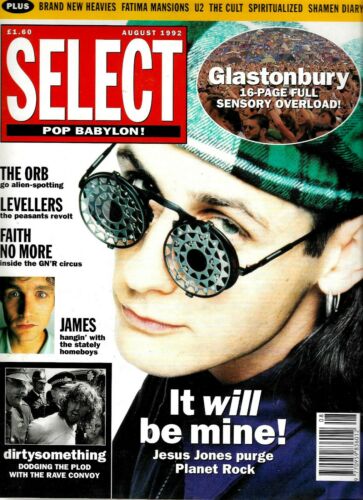 Andrew Harrison, 25, Select Magazine Editor: I drove back without sleep, six hour drive and into the office, horse-whipping them into writing something up from their notes. And we fucking did it, 16 pages, colour photographs, it was a huge success. It was reported to me that the following week, [NME Editor] Danny Kelly presented Select’s coverage to the staff and shouted, “They fucking destroyed us!”. I looked at the NME as the establishment – they were very arrogant – and that was what I wanted to do. Select’s coverage was the beginning of taking Glastonbury out of the music press fringes to where it is now with the BBC.
Andrew Harrison, 25, Select Magazine Editor: I drove back without sleep, six hour drive and into the office, horse-whipping them into writing something up from their notes. And we fucking did it, 16 pages, colour photographs, it was a huge success. It was reported to me that the following week, [NME Editor] Danny Kelly presented Select’s coverage to the staff and shouted, “They fucking destroyed us!”. I looked at the NME as the establishment – they were very arrogant – and that was what I wanted to do. Select’s coverage was the beginning of taking Glastonbury out of the music press fringes to where it is now with the BBC.
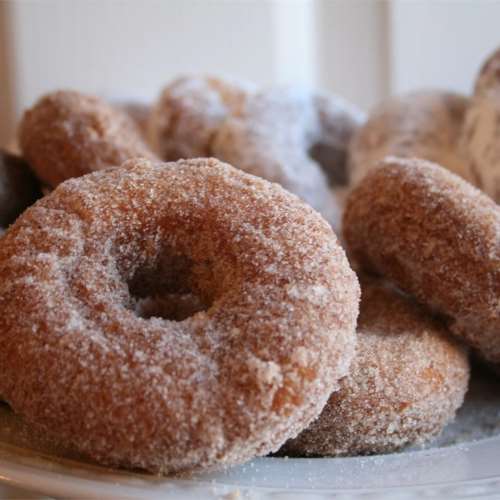 Jiří Sandoz, 21, festival-goer: I wandered around most of Sunday night with this guy we knew who was famously miserable but I was so catatonically depressed eventually even he said I was downer. So I hitched to Bath, got a train back to Birmingham, and turned up at the dress rehearsal for my show. I hadn't slept or eaten since Glastonbury. I was playing this tough guy and at the end of the play I go up to this guy, push him over and say, “Leave it out, granddad,” then walk off, then curtain. I’d lost all sense of reality. I was starving hungry. I went on stage, then I noticed there was all this prop food on the table. In my strangely psychedelic state all the illusion of theatre broke. All I could think was I hadn’t eaten for three days, so I just started munching all these donuts and cream cakes on the stage. The audience were waiting. And waiting. Eventually I came to my senses. “Leave it out, grandad.” Curtain. Everyone clapped. And I ran back to my student flat.
Jiří Sandoz, 21, festival-goer: I wandered around most of Sunday night with this guy we knew who was famously miserable but I was so catatonically depressed eventually even he said I was downer. So I hitched to Bath, got a train back to Birmingham, and turned up at the dress rehearsal for my show. I hadn't slept or eaten since Glastonbury. I was playing this tough guy and at the end of the play I go up to this guy, push him over and say, “Leave it out, granddad,” then walk off, then curtain. I’d lost all sense of reality. I was starving hungry. I went on stage, then I noticed there was all this prop food on the table. In my strangely psychedelic state all the illusion of theatre broke. All I could think was I hadn’t eaten for three days, so I just started munching all these donuts and cream cakes on the stage. The audience were waiting. And waiting. Eventually I came to my senses. “Leave it out, grandad.” Curtain. Everyone clapped. And I ran back to my student flat.
Kevin Geraghty-Shewan, 30, festival-goer: As we were walking from the site Val confessed that she was disappointed she hadn’t actually had the baby at the festival. Our daughter Rhianna was eventually born on 22nd August.
Pat Corley, 39, festival-goer and book-seller: Me and Kim went down to the coast to chill out for a couple of days and camped at Durdle Door. When we walked over the hill, we discovered Lulworth Cove was packed with Glastonbury people who all had the same idea. We even met someone we knew from Glasto. He was making little pottery Buddhas, so we bought one off him that I have to this very day.
- *POSTCRIPT* Since this feature appeared, key members of Bedlam Sound System have convincingly suggested to the author that Bedlam were not at Glastonbury 1992 (they were at Smeatharpe Free Festival in Devon). Others suggest elements of Bedlam may have been at Glastonbury, although this is categorically denied by the aforementioned key Bedlam members. Steve Bedlam, when interviewed for this feature, did say that he wasn't sure whether his memories derived from 1992 or 1993 but I assumed '92 as I had strong memories of a Bedlam party through Sunday night. There were certainly Bedlam shout-outs from the sound system but perhaps the wild frazzledness of the occasion and the distance ago in time plays a role in the confusion. Even if Bedlam were not there in any form, as now seems possible, Steve Bedlam's comments remain in the feature as they're generally pertinent and fit with the whole.
Further info in regard to those who contributed memories
The interviews with Mark Cann, John Sauven, Ivan McBeth, Tony Andrews and the late Arabella Churchill are adapted, with permission, from Crispin Aubrey & John Shearlaw’s 2004 book Glastonbury: An Oral History of the Music Mud and Magic
More writing from Kevin Geraghty-Shewin can be found here
More writing from Russell Hiscox can be found here
More writing from Pat Corley can be found here
Bobby Gillespie’s autobiography Tenement Kid, arrives in October via Orion Publishing.
Babble On An' Ting - Alex Paterson's Incredible Journey Beyond The Ultraworld with The Orb, by Kris Needs with Alex Paterson is out now on Omnibus Press, and Alex would like to draw attention to the radio station WNBC.London where The Orb present a show every third Wednesday of the month, 3.00 – 6.00 PM.
Martha D Lewis and Eve Polycarpou continue to record and perform together and separately – more info here
Stefan Linne continues to perform and can be found here
Joe Louis Walker continues to record and perform and can be found here
Thank you to CUD for the two photographs of them live at Glastonbury 1992. CUD continue to record and perform and can be found here
Andrew Harrison’s BIGMOUTH and THE BUNKER podcasts can be found on Apple Podcasts
Photography details
Massive thanks for the generosity of the following (to whom the photos attributed are copyrighted):
Grant Fleming, for allowing use of the black'n'white shot of Primal Scream from the back, playing the NME Stage, and the black'n'white shot of tent city taken from Primal Scream's tour bus. Grant Fleming Instagram here.
Clive Farndon, for allowing use of the three shots of Worthy Farm cows in festival situ, the wicker man, the two guys on the Pyramid, and the fire dragon, all taken around the time of the 1992 festival.
Ian Sumner, for allowing use of the black'n'white shots of the magic mushroom people, the notice board, the love sculpture, the sleeping bag guy, and Michael Eavis with dandelion clock. Some of these photographs may not have been taken around the 1992 festival but they are from that era and fit.
Rosie the Riveter and Rowan Chapman who contributed jovially incriminating reportage of their own Glastonbury 1992. You are both stars.
rating
Explore topics
Share this article
Add comment
The future of Arts Journalism
You can stop theartsdesk.com closing!
We urgently need financing to survive. Our fundraising drive has thus far raised £49,000 but we need to reach £100,000 or we will be forced to close. Please contribute here: https://gofund.me/c3f6033d
And if you can forward this information to anyone who might assist, we’d be grateful.

Subscribe to theartsdesk.com
Thank you for continuing to read our work on theartsdesk.com. For unlimited access to every article in its entirety, including our archive of more than 15,000 pieces, we're asking for £5 per month or £40 per year. We feel it's a very good deal, and hope you do too.
To take a subscription now simply click here.
And if you're looking for that extra gift for a friend or family member, why not treat them to a theartsdesk.com gift subscription?
more New music
 'Deadbeat': Tame Impala's downbeat rave-inspired latest
Fifth album from Australian project grooves but falls flat
'Deadbeat': Tame Impala's downbeat rave-inspired latest
Fifth album from Australian project grooves but falls flat
 Heartbreak and soaring beauty on Chrissie Hynde & Pals' Duets Special
The great Pretender at her most romantic and on the form of her life
Heartbreak and soaring beauty on Chrissie Hynde & Pals' Duets Special
The great Pretender at her most romantic and on the form of her life
 The Last Dinner Party's 'From the Pyre' is as enjoyable as it is over-the-top
Musically sophisticated five-piece ramp up the excesses but remain contagiously pop
The Last Dinner Party's 'From the Pyre' is as enjoyable as it is over-the-top
Musically sophisticated five-piece ramp up the excesses but remain contagiously pop
 Moroccan Gnawa comes to Manhattan with 'Saha Gnawa'
Trance and tradition meet Afrofuturism in Manhattan
Moroccan Gnawa comes to Manhattan with 'Saha Gnawa'
Trance and tradition meet Afrofuturism in Manhattan
 Soulwax’s 'All Systems Are Lying' lays down some tasty yet gritty electro-pop
Belgian dancefloor veterans return to the fray with a dark, pop-orientated sound
Soulwax’s 'All Systems Are Lying' lays down some tasty yet gritty electro-pop
Belgian dancefloor veterans return to the fray with a dark, pop-orientated sound
 Music Reissues Weekly: Marc and the Mambas - Three Black Nights Of Little Black Bites
When Marc Almond took time out from Soft Cell
Music Reissues Weekly: Marc and the Mambas - Three Black Nights Of Little Black Bites
When Marc Almond took time out from Soft Cell
 Album: Mobb Deep - Infinite
A solid tribute to a legendary history
Album: Mobb Deep - Infinite
A solid tribute to a legendary history
 Album: Boz Scaggs - Detour
Smooth and soulful standards from an old pro
Album: Boz Scaggs - Detour
Smooth and soulful standards from an old pro
 Emily A. Sprague realises a Japanese dream on 'Cloud Time'
A set of live improvisations that drift in and out of real beauty
Emily A. Sprague realises a Japanese dream on 'Cloud Time'
A set of live improvisations that drift in and out of real beauty
 Trio Da Kali, Milton Court review - Mali masters make the ancient new
Three supreme musicians from Bamako in transcendent mood
Trio Da Kali, Milton Court review - Mali masters make the ancient new
Three supreme musicians from Bamako in transcendent mood
 Hollie Cook's 'Shy Girl' isn't heavyweight but has a summery reggae lilt
Tropical-tinted downtempo pop that's likeable if uneventful
Hollie Cook's 'Shy Girl' isn't heavyweight but has a summery reggae lilt
Tropical-tinted downtempo pop that's likeable if uneventful

Comments
Can i add a little more on
Thanks, Andrew, your memories
Thanks, Andrew, your memories are welcome addition.